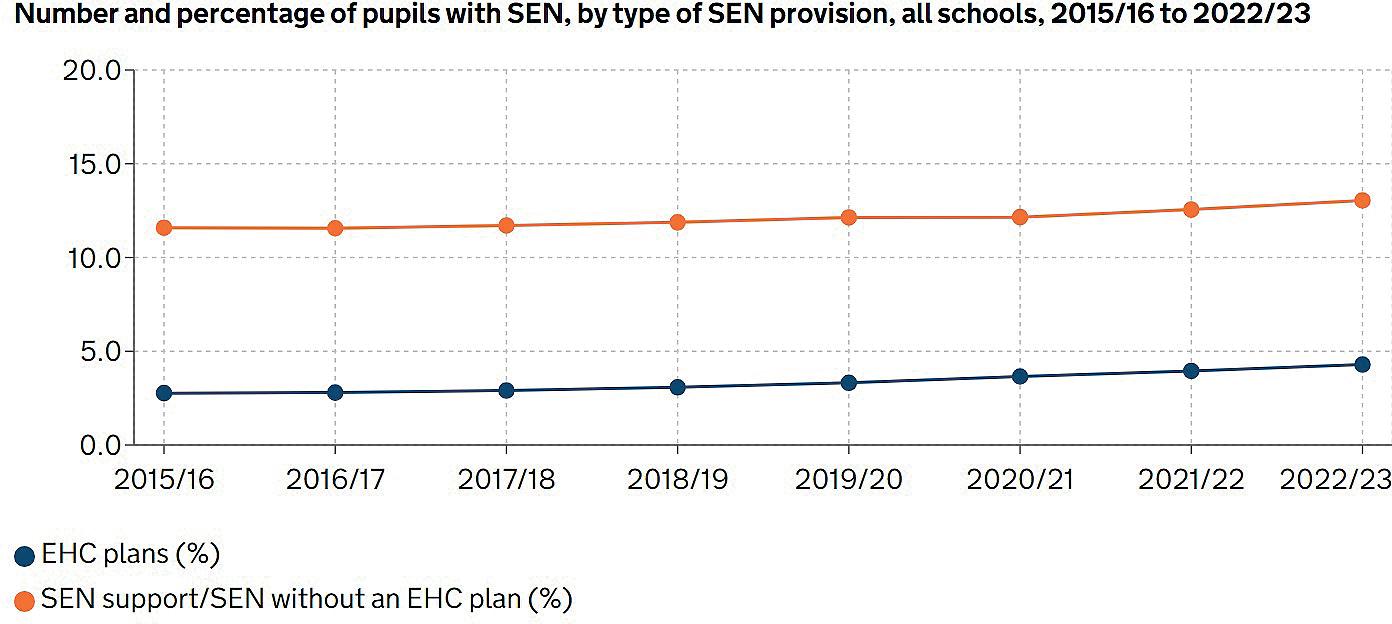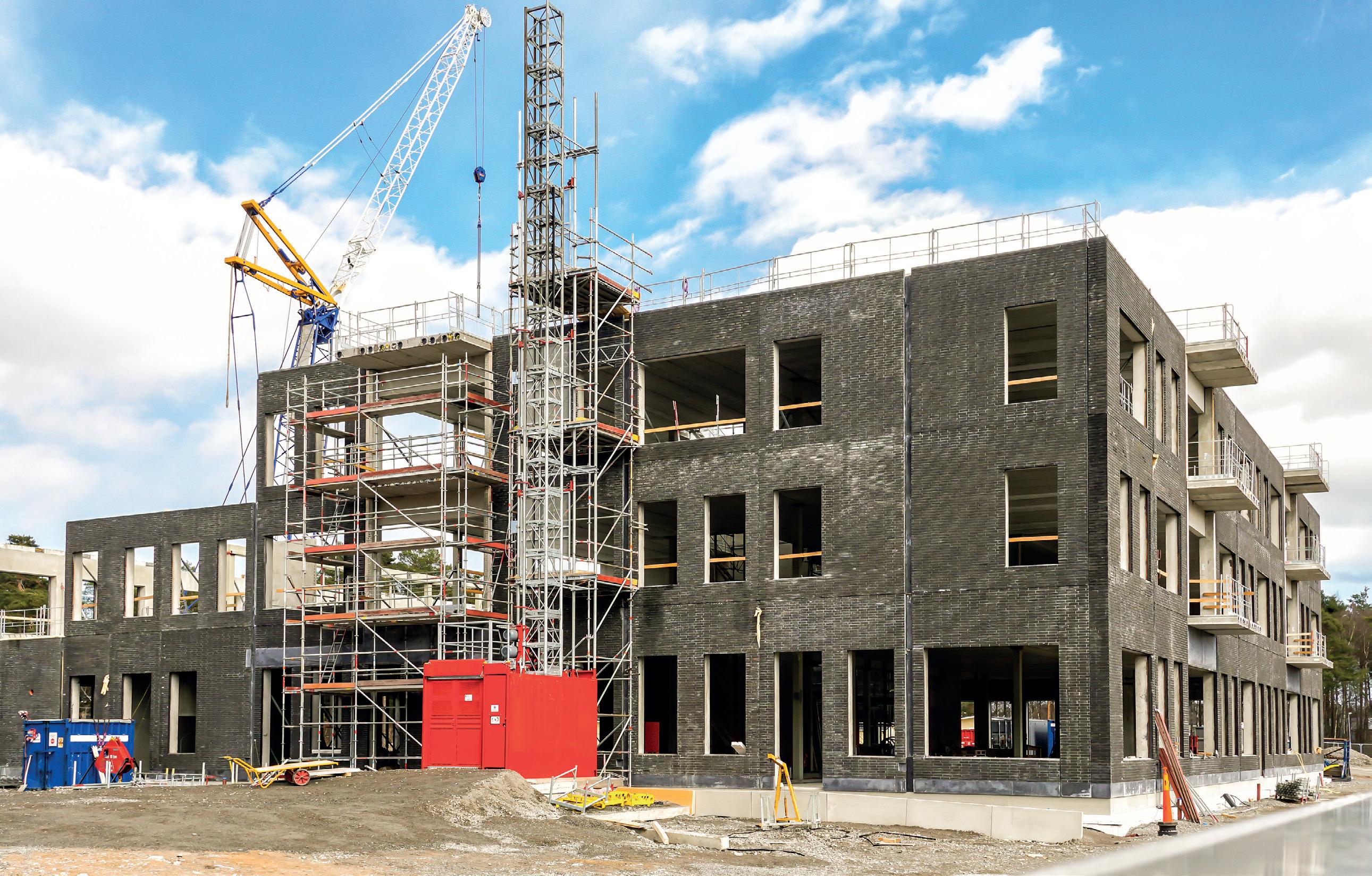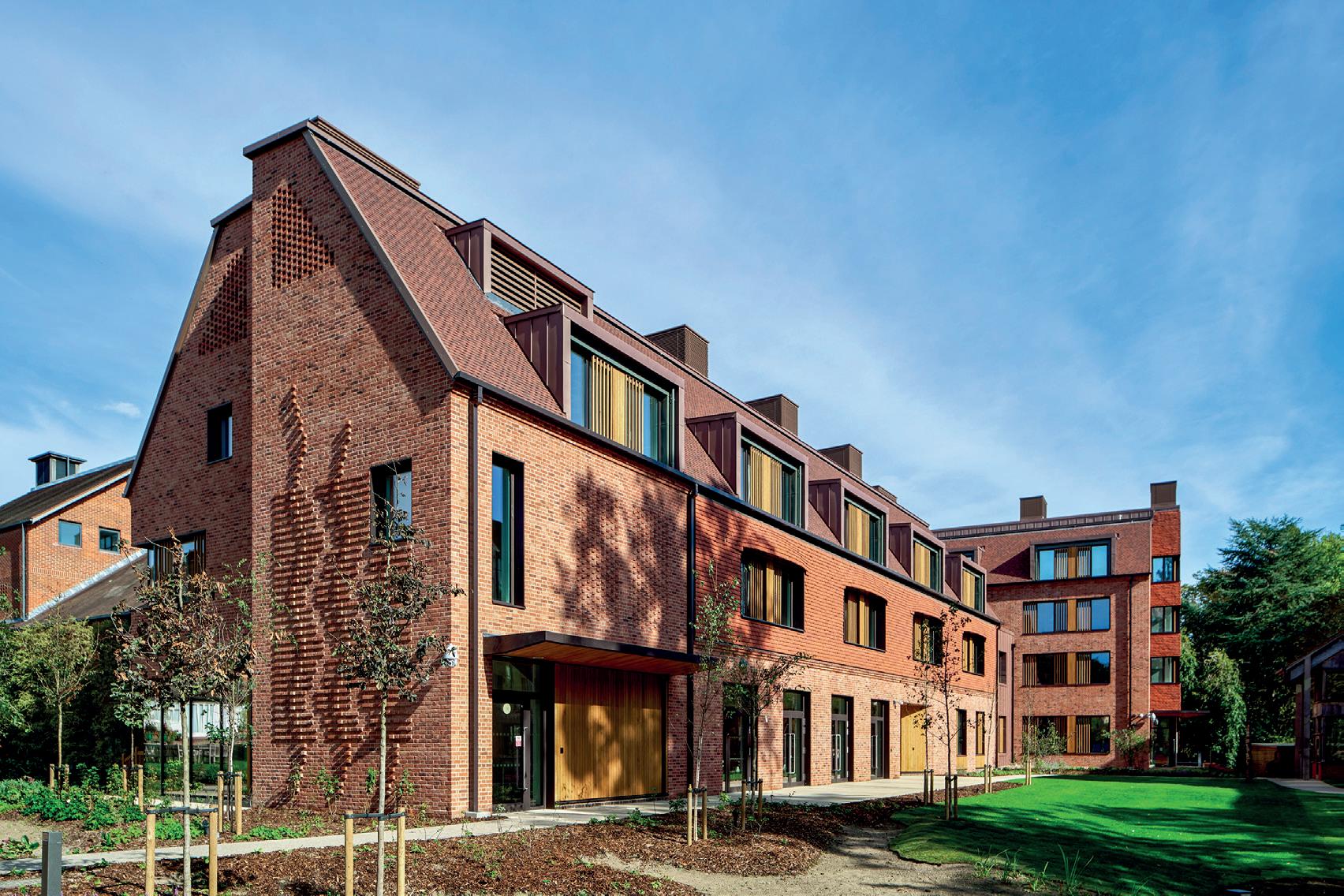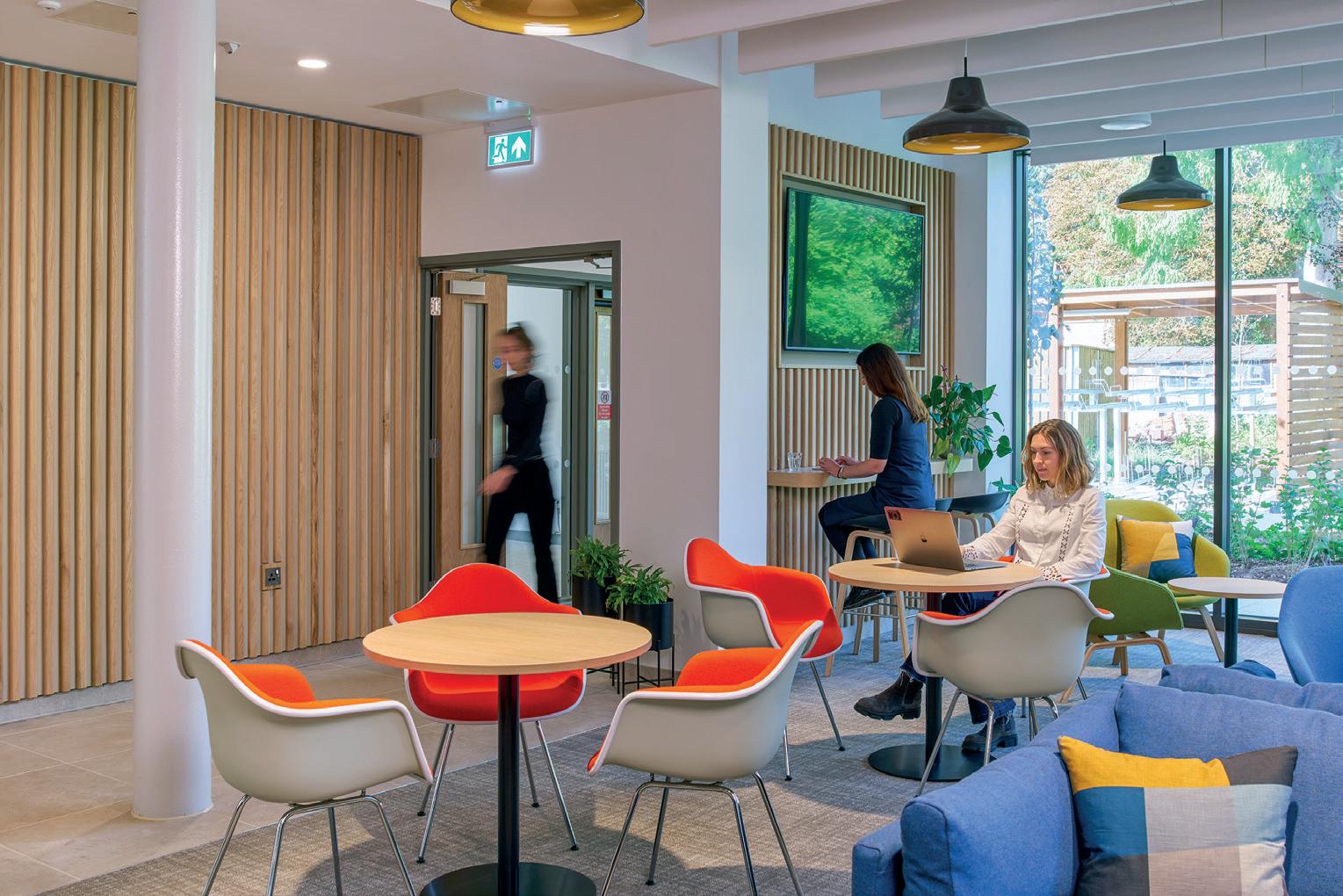APRIL-MAY 2024


Special report on the design of purpose-built student accommodation
How modern methods of construction are creating a new generation of educational buildings
Guidance supports estates professionals to get the most from their sites
EDUCATION-PROPERTY.COM 04/2024







Cash flow concerns remain WELCOME
Welcome to the latest edition of Education Property magazine, which comes shortly after the announcement of the Spring Budget.
Unfortunately, this muchanticipated annual spending review did very little to quell ongoing concerns over education funding, with Chancellor, Jeremy Hunt, largely ignoring the sector aside from plans for a £105m investment in 15 new special schools.
While welcomed, this cash is just the tip of the iceberg as the demand for special educational needs and disabilities (SEND) places rockets across the country.
In fact, the shortage of SEND places has led to a groundswell in demand for suitable properties.

And you can read about this in our report on page 14, which explores the reasons for this high demand and what education providers are looking for from properties.
In this edition there is also a special report on purpose-built student accommodation (PBSA) and the key design drivers.
This article cites the findings of a new report by The Property Marketing Strategists, which reveals that the needs of international students are impacting the way in which architects design these facilities.
And there is a report on the increasing interest in using the Passivhaus standard for PBSA schemes
About Jo: Jo is the editor of Education Property, having joined Nexus Media in November.
She has been specialising in design and construction best practice for the past 14 years, working on the Building Better Healthcare Awards and editing both
in order to drive efficiency and create futureproofed accommodation.
We also focus on the use of modern methods of construction in the delivery of educational buildings.
Using this offsite approach means facilities can be delivered quicker, more cheaply, and with less impact on live school sites.
But it’s not just the buildings themselves that we are focusing on. Education Property is also looking to support those professionals who operate these estates.
In this edition we have details of new guidance on how to implement effective estates strategies, as well as an indepth overview of Estate
Energy efficiency remains at the forefront of estates and facilities management efforts and over the coming months we will be looking more closely at the opportunities and challenges facing the sector.
In the next edition, we will be focusing on how to reduce school closures, the storage needs of educational facilities, and lighting solutions.
If you can help, please contact joanne.makosinski@nexusgroup.co.uk
Jo Makosinski Editor Education Property
Building Better Healthcare and Healthcare Design & Management magazines.
She has a special interest in the design of public buildings including schools, nurseries, colleges, hospitals, health centres, and libraries.
Comment EDUCATION-PROPERTY.COM APRIL-MAY 2024 | 3



15 new special schools promised in Spring Budget
Fifteen new special free schools will be built in England at a cost of £105m, Chancellor, Jeremy Hunt, announced in his Spring Budget.
However, this was one of the few education-related commitments in his speech, drawing criticism from sector leaders.
In budget documents, the Treasury said it was ‘committing an initial £105m towards a wave of 15 new special free schools to create over 2,000 additional places for children with special educational needs and disabilities (SEND) across England’.
“This will help more children receive a world-class education and builds on the significant levels of capital funding for SEND,” Hunt said.
Locations for the schools will be announced in May, he added.
A FUNDING CRISIS
The Government also confirmed the location of 20 alternative provision free schools, which were originally announced as part of a £2.6bn capital investment at the 2021 spending review.
However, critics have said this will go nowhere near meeting the shortage of SEND places in many areas.
Commenting on his speech, which centred on tax cuts for workers and parents, Julie McCulloch, director of policy at the Association of School and College Leaders, said the Chancellor ‘spent more time namechecking film stars than he did on education’.
She added: “A building programme for special schools is welcome, but does not address the wider crisis in special educational needs funding.”
THE POOR RELATION
The only other announcements which impact on the education sector include news that the household support fund — which has been used by some councils to provide school uniform support or holiday meals — will be extended from April to September at a cost of £500m; and that the Government will spend £75m over three years from 2025 to expand the violence reduction unit model across England and Wales, which enables health boards, schools, and police leaders to co-ordinate joint strategies to tackle violence among young people.
But there was no mention of the National

Tutoring Programme, suggesting funding for subsidised tuition will come to an end this summer as planned.
If this happens schools will be expected to use pupil premium funding if they want to keep these going.
A ‘WOEFUL’ APPROACH
Nick Brook, who chairs the Department for Education’s tutoring advisory group, said the failure to fund it at the budget has ‘brought the curtain crashing down on the programme, the only response of merit from [the Government’s} woeful post-COVID education recovery plan’.
“Schools will undoubtedly do their upmost to maintain levels of support for their mostdisadvantaged pupils,” he added.
“But, with dwindling resources, it is abundantly clear that this decision will result in the volume of tutoring plummeting.”
There was also no mention of additional funding for national professional qualifications, which comes to an end at the end of this academic year.
LACK OF SUPPPORT
Responding to the Chancellor’s Spring Budget, Natalie Perera, chief executive of the Education Policy Institute (EPI), said she was ‘disappointed’ at a lack of financial
support for early years and education, adding: “Research published by EPI found that pupils are still feeling the effects of the COVID-19 pandemic, with those from poorer families struggling the most to catch up.
“If the Government is serious about delivering a world-class education for all, it needs to prioritise spending in the early years, targeted to families who need it the most, as well as a sufficiently-funded high-quality universal offer. It also needs to prioritise funding for disadvantaged pupils in schools and colleges. This includes increasing funding and support for pupils with Special Educational Needs and Disabilities (SEND), providing mental health support in schools, and considering how best to support schools to offer an extended school day.
“But we also cannot expect schools in isolation to fix all of society’s problems.
“The increase to the child benefit threshold [from £50,000 to £60,000] is a positive step, but there is an urgent need for a crossgovernment child poverty strategy which recognises the root causes of education inequalities such as poverty, housing, healthcare, transport, and many other aspects of daily life.”
For more information on the SEND market, turn to page 14
6 | APRIL-MAY 2024 EDUCATION-PROPERTY.COM News
Jeremy Hunt. Image by Simon Walker, No 10 Downing Street

SEN
school contractor chosen
Tilbury Douglas has been appointed to lead the construction of Tulip Academy in Spalding on behalf of the Department for Education (DfE) for the Community Inclusive Trust (C.I.T Academies).
The project will deliver a new-build, twostorey, Special Educational Needs (SEN) school for children and young adults aged 11-16 with a range of learning difficulties and disabilities, replacing existing outdated accommodation.
The school will benefit from operational savings and the build must be net zero carbon in operation, utilising photovoltaic
panels on the roof, natural ventilation with heat recovery (NVHR) units, cross ventilation, and air source heat pumps.
The plan also includes a range of external works, with an aim to meet the Urban Greening factor and the DfE’s biodiversity specification, with landscaping a key consideration.
Simon Butler, managing director of building for the central region at Tilbury Douglas, said: “As this important scheme is located on a live school environment, we are working closely with the school and DfE to ensure minimal disruption to the day-to-
day running of the school. We aim to deliver a first-class asset for C.I.T Academies.”
Matthew Bloodworth-Flatt, headteacher of Tulip Academy Spalding, added: “This is a very-exciting time for the school and pupils and staff will be looking on with anticipation watching the new building take shape.
“The purpose-built school building will help us hugely with our mission of ‘Making every Moment Matter’, preparing pupils for their futures and helping them develop knowledge and skills which will allow them to thrive in adult life.”

EDUCATION-PROPERTY.COM APRIL-MAY 2024 | 7
Building communities for learning
Local authorities across Wales are continuing to plan for future educational needs, with proposals being submitted to the Welsh Government’s Sustainable Communities for Learning programme.
Launched in January 2022, and formerly known at the 21st Century Schools Programme, the funding model provides a rolling programme of infrastructure projects covering a nine-year period split into three sections of three years each.
The first three years up to 2027 will be made up of projects expected to reach full business case stage.
The projects in the second three-year period up to 2030 are those that are being developed and need to go through consultation.
And the last period covers long-term ‘pipeline’ projects.
Local authorities will review their programme every three years and, over its lifespan, the model is expected to deliver over £1.5bn worth of improved learning facilities underpinned by the Government’s net-zero carbon commitment.
Funding for approved schemes comes primarily from the Government, although councils are expected to contribute.
The current rate is that proposals for community, voluntarycontrolled, and foundation schools receive 65% of funding from the Government, with special schools and pupil referral units getting 75%, and voluntary-aided schools of religious character getting 85%.
At a recent meeting of the Blaenau Gwent County Borough Council’s Cabinet, education portfolio holder, Councillor Sue Edmunds, gave an update on projects being taken forward under the programme, including plans for extensions at two secondary schools that are full to capacity.
Under the first tranche of the programme, the council is hoping to deliver £24m worth of improvements at Ebbw Fawr Learning Community, Tredegar Comprehensive School, and Pen y Cwm Special School.
In the medium term, Cllr Edmunds said they were looking at refurbishment and new-build projects at five schools; and the future


In Monmouthshire, projects already under construction include a new net-zero-carbon ‘all-through’ school in Abergavenny, which will deliver education for pupils aged from 3-19.
Being built by Morgan Sindall Construction, the project is due for completion by next summer.
And Rhondda Cynon Taf County Borough Council has completed a number of projects, with work ongoing to build three new primary and all-through schools and extensions to existing facilities at five other sites.
Work to start on new MAT school
Work has started on the construction of Branston Locks Primary & Nursery School in Tatenhill, Staffordshire.
Contractor, Tilbury Douglas, has been appointed to lead the work on behalf of the Department for Education (DfE) for John Taylor Multi-Academy Trust (MAT).
The new-build, two-form entry primary school with nursery, situated in the proposed ‘local centre’ of a new residential/ mixed-use development, is designed to eventually accommodate 420 primary school pupils aged 4-11 years and provide an additional 52 nursery places.
The school will open with one form of entry in September this year, admitting one reception class with 30 places and a nursery with 26 places for children over three years of age.
To meet the DfE’s sustainability objectives, the development is set to achieve net-zero carbon in operation at handover.
This will be achieved by utilising highlyenergy-efficient fabric and services, offset by onsite renewables.
In addition, the landscaping will feature new trees and meadow planting around the site boundary, providing valuable habitat and increasing biodiversity, as well as creating spaces for outdoor learning.
The proposed external sports provision also includes new pitches and running tracks.
In addition to its core education use, the new school will look to become a vibrant community hub, with an activity studio, large main hall, and associated kitchenette and storage.


8 | APRIL-MAY 2024 EDUCATION-PROPERTY.COM News

Plans for multi-million-pound special school
Plans to rebuild Pens Meadow School special school are taking a step forward with a contractor now appointed to deliver the work.
Dudley Council is investing £15m in the new school, which is to be built on the site of the former Pensnett High School.
Contractor, Interclass PLC, a local company based in Wombourne, will be delivering the build with initial site preparatory work to begin this spring.
Once built, the school will provide education for 155 children and young people aged 3-19 together with a nursery assessment unit for the borough.

The purpose-built unit will deliver better facilities for pupils with complex needs, severe learning difficulties, including autism, and those with profound and multiple learning difficulties.
It will have state-of-theart art equipment, therapy rooms, a hydrotherapy pool, changing facilities, outdoor teaching and play areas, and 14 bespoke classrooms specifically designed to cater to children with additional needs.
There is also a focus on sustainability within the design, with plans for PV panels to turn sunlight into electricity and air source heat pumps to help heat the building.
project design and delivery team in corporate landlord services.
And work is expected to start on site this month and is due to be completed in the summer of a phased transition for some of the pupils to the new site starting in the autumn of 2025.
Councillor Patrick Harley, leader of the council, said: “Pens
provision to the next level.
“It has been designed to significantly improve the education for children and young people with complex needs and I’m delighted that we now have a contractor in place to deliver this ambitious build.”

Marie Hunter, headteacher, added: “Our whole school community is very excited that the building of our new school will begin this spring.
“We have been working closely with the planning teams and are looking forward to seeing the building works progress. This will provide our pupils and families with the excellent environment they
EDUCATION-PROPERTY.COM APRIL-MAY 2024 | 9
Pictured are Marie Hunter, head of Pens Meadow, and Councillor Patrick Harley, leader of Dudley Council

Government funding claims ‘unhelpful to public debate’
An insight into the latest report from the Institute for Fiscal Studies, which sheds light on education spending
Government claims that school funding is at a record or historical high is ‘not much of an achievement’, according to a new report from The Institute for Fiscal Studies (IFS).
Published on 1 March, The latest picture on School Funding and costs in England provides an up-to-date analysis of trends in school funding and costs in England over time.
And it reveals that, if the Government wanted to compensate schools for the 5% loss in the purchasing power of budgets since 2009-10, it would require a total of £3.2bn in extra funding.
The report states that the core schools budget in England is set to be about £60bn in 2024-25, which includes day-to-day or current school spending on pupils aged 5-16.
Total spending is up about 11% in real terms on the level seen five years ago in 2019-20.
But it states: “The Government regularly makes the claim that school funding is at a record or historical high.
“While technically true, this is not much of an achievement.
“Practically every government could make this claim every year back to at least 1945, if not earlier.
“There are now an extra 900,000 — or 15% — more pupils than there were in 2010 and these pupils require extra teachers, extra books, extra seats, and total spending has thus gone up to meet this extra need.”
Figure 1 shows the IFS’s estimates of the
total level of school spending per pupil, relative to its level in 2009-10.
The report states: “Following a
Based on general inflation
Based on
substantial rise over the 2000s, total school spending per pupil fell by 9% in real terms in England between 2009-10 and 2019-20.
This fall in school spending per pupil represents the largest and most-sustained cut in school spending per pupil in England in at least 40 years, and probably a lot longer
10 | APRIL-MAY 2024 EDUCATION-PROPERTY.COM Finance and Property
1.05 1.00 0.95 0.90 0.85 0.80 Financial year
Relactive to real-terms level in 2009-10 2003-04 2004-05 2005-06 2006-07 2007-08 2008-09 2009-10 2010-11 2011-12 2012-13 2013-14 2014-15 2015-16 2016-17 2017-18 2018-19 2019-20 2020-21 2021-22 2022-23 2023-24 2024-25
schools-specific
cost inflation
Figure 1
Note and source: updated version of figure 3.2 in Drayton et al. (2023). General inflation by some HM Treasury, GDP deflators, December 2023. Schools-specific cost inflation detailed in Drayton.
“This fall in school spending per pupil represents the largest and most-sustained cut in school spending per pupil in England in at least 40 years, and probably a lot longer.”
It adds: “Since 2019-20, we have seen rises in school spending, which is likely to lead to a 9.5% real-terms increase between 2019-20 and 2024-25.
REVERSING THE TREND
“If delivered, this should be sufficient to reverse past cuts and take school spending per pupil back to its last historical high in 2009-10.
“Technically, we therefore also expect school spending per pupil to be at an equal historical high in 2024-25.
“Again, however, this is not really much of an achievement.
“Prior to 2010, school spending per pupil was usually at a record level every year.
“As a society, we have generally chosen to increase real-terms spending on schools as we have seen economic growth and become richer.
“The fact that school spending per pupil was not at a record high between 20102023 reflects the fact that we have just seen a historically-large real-terms cut in spending per pupil.”
Furthermore, the report reveals these trends do not account for the large drop in school capital spending, which has fallen significantly over time.
The three-year average up to 2023-24 is due to be about 26% lower in real terms than the three-year average in the late 2000s up to 2008-09.
And this all comes at a time when schools are facing increased costs.
RISING COSTS
The report states that average teacher pay per head grew by 6% in 2023-24, other staff pay per head increased by over 8%, and non-staff costs grew by 6%.
However, funding per pupil grew by 8.0% in 2023-24, which was just about sufficient, on average, to compensate schools for cost rises of 7.2%.
For 2024-25, the GDP deflator — the standard and most-consistent way to examine real-terms changes in public spending — is currently forecast to be 1.7%.
And, with funding per pupil due to grow by 3.8%, this equates to real-terms growth in school funding per pupil of about 2% and allows spending per pupil to return to 200910 levels by 2024-25, as shown in Figure 1.
However, the IFS analysis suggests that school costs are actually likely to grow by 5%, outpacing funding growth and driving a 1% cut in the purchasing power of school budgets.
2023-24 2024-25 Financial year
This projected increase in costs is based on a range of assumptions including teacher pay increasing and cost pressures from highneeds or special education needs provision.
In conclusion, the report states: “The government regularly claims that school funding and funding per pupil are at record highs. Such claims are, to put it mildly, unhelpful to public debate.
“Prior to 2010, school funding per pupil was at a record high almost every year. The fact that this has not been the case since 2010 just reflects the fact that we have seen historically-large cuts to school spending per pupil.
“Furthermore, the actual costs faced by schools are growing faster than overall inflation, such that the actual pressures on school budgets are likely to be much more challenging than when we use standard measures of inflation to calculate real-terms changes in school funding per pupil.
“On current policy and projections, we expect a 1% fall in the purchasing power of school budgets in 2024-25.
LASTING EFFECTS
“If the Government wanted to compensate schools fully for the expected cost rises, school funding would need to rise by a further £700m over and above existing plans for 2024-25.
“If the Government wanted to go even further and compensate schools for the 5% loss in the purchasing power of school budgets since 2009–10, it would require a total of £3.2bn in extra funding.”
Responding to the report, Daniel Kebede, general secretary of the National Education Union (NEU), said: “The NEU agrees with the IFS that the correct way to chart progress in the education system is by reference to school costs.
If the Government wanted to go even further and compensate schools for the 5% loss in the purchasing power of school budgets since 2009–10, it would require a total of £3.2bn in extra funding
“It is school purchasing power that counts in providing an education system fit for the 21st Century.
“Persistent underfunding has led to deep and lasting effects on the education sector.
“70% of schools in England have lower real-terms funding this year than in 2010 and 380 schools have lost more than £2,000 in real terms per pupil funding due to government cuts.
“Up until this point Government has not listened to the clear evidence put in front of them. They are ignoring a growing existential crisis in education that is happening on their watch.” n
Finance and Property EDUCATION-PROPERTY.COM APRIL-MAY 2024 | 11
Figure 2
10% 8% 6% 4% 2% 0% -2% Total funding per child School cost GDP deflator
Note and source: figure for cash times funding per pupil taken from Drayton et al. (2023). GDP deflator taken from HM Treasury, GDP deflators, December 2023. Schools-specific cost index detailed in Drayton et al. (2023), plus an additional assumption that support staff pay per head.
2020-21
2021-22 2022-23
Percentage change

Top issues for bursars for 2024

Independent schools face unique challenges related to property and its management. This article by Morgan Allen, a partner at Gerald Eve, covers these issues and how they can be addressed
1. PROTECTING ASSETS
The imposition of VAT on school fees is almost certain under a future Labour government, which is adding considerable uncertainty to the independent schools sector.
Some schools are seeking to protect their assets by entering into PropCo OpCo arrangements, under which a lease is put in place and we would strongly recommend that expert independent property advice is sought on the detailed lease terms.
These can have material implications for the value of the interests, control, securing mortgage funding, and other such matters.
2. RELEASING CAPITAL
The need to invest in school facilities in order to enhance parent appeal — with ever higher expectations — and attract and retain pupils is a constant issue at most independent schools.
And inflation and budgetary pressures for schools have impacted on some schools’ ability to undertake new building projects.
However, there are a number of options
for schools to realise capital from their estate to invest back into facilities.
Debt funding through secured lending founded on a realistic business plan remains the ‘go to’ for many schools.
While the cost of debt has increased, there are still a number of lenders active in the market and we are beginning to see a recovery in the number of secured lending valuations being undertaken of schools.
That said, the main clearers generally prefer to lend to their existing borrowers rather than lending to ‘new to bank’ school borrowers.
We have seen a number of the challenger banks show increasing appetite to lend into the schools sector, although their margins (interest rates) tend to be more expensive than those of the top high street banks.
Having a ‘Red Book’ valuation prepared by a valuation firm that is immersed in the schools market is key here.
Schools facing a re-finance of existing debt in the next couple of years are likely to find that lenders will demand to see robust stress-testing of forecast cashflows to ensure
that, in the unfortunate event there is a decline in pupil numbers (turnover), the school’s trading activity could still amply cover the repayments.
In addition, loan-to-value ratios have declined at the same time as interest rates have increased; and this means that it now costs more to borrow less.
Schools which are already highly leveraged may struggle to refinance over the next couple of years.
We are the leading adviser on sale and leasebacks and ground rent disposals in the independent schools market, which can be an innovative way of raising valuable capital for schools without adversely impacting upon trading operations.
A sale and leaseback is an established method of releasing capital from property, whereby the occupier would sell the freehold asset to an investor and simultaneously take a lease back for a fixed period of typically 15-35 years at a market rent.
A ground rent disposal is a lower-risk option for both the occupier and investor and can provide schools with long-term security of tenure with the potential to recover the freehold for a nominal sum after, say, 50-75 years.
The leaseback period in a ground rent deal is generally 100-150 years at a muchlower, sustainable rent.
This can be an attractive funding option for those with weaker credit profiles/ covenant strength and those requiring a commitment to the property for the foreseeable future.
That said, if a school is struggling, investor appetite might be muted and there would be virtually no investor appetite for a loss-making school.
Many schools may also have surplus assets that can either generate income or be sold to release capital. This may take the form of surplus land within the school estate, underutilised staff houses, and/or surplus school buildings that you may be able to sell/lease to another user.
Finally, there have been a growing number of mergers and acquisitions in the schools market in recent years.
There are opportunities to explore mergers, joint venture, or shared services opportunities to improve economies of scale, pool expertise, and enhance market share in a more-competitive market.
A merger would offer the opportunity to reduce often expensive ‘head office’ costs via reducing duplicated roles such as a bursar, marketing, payroll, etc.
We expect forward-thinking bursars will have already stress tested forecast cashflows to account for VAT on school fees and the
12 | APRIL-MAY 2024 EDUCATION-PROPERTY.COM Finance and Property
Image: Vidhyarthi Darpan from Pixabay
potential impact this may have on pupil numbers.
And bursars and governors are likely to have considered or even approached other schools to discuss opportunities for mergers.
3. DIVERSIFYING INCOME
Buying or merging with a feeder school offers a good way to protect a future pipeline of pupils.
We are also seeing schools create nurseries (if they don’t already have one), to protect the pupil pipeline into Reception.
Furthermore, early years will not attract VAT, so introducing a nursery would boost income which would not be subject to VAT and also diversity income streams.
Very careful consideration would need to be given to the model of nursery, though; ie term-time only, or full 51-week wraparound day care.
We have seen schools introduce a termtime only nursery and then struggle to fill places in catchments where parents require full wrap-around day care instead, and then fail to successfully transition to such a model.
A hybrid sessional nursery school and wraparound day care model is often inefficient.
We would strongly recommend to a school considering introducing a nursery that you obtain a report on the catchment analysis and population projections to ensure a proposed nursery would have sufficient demand to fill places and which type of model to adopt.
VAT on fees for pupils with an Education Health and Care Plan (EHCP) will also not attract VAT.
We therefore predict a huge surge in parents seeking referrals for EHCPs in order to mitigate the cost of tuition fees.
Schools might as a result want to consider bolstering their SEND departments in due course to meet this predicted increase in demand.
4. PROJECT MANAGEMENT
School estates are continually evolving in response to changing educational priorities, the need to replace outdated infrastructure, to create more-flexible accommodation, or to add new facilities.
And, while new projects are exciting and are enthusiastically welcomed by governors, parents and staff, for the bursar they can be a time-consuming diversion from day-today responsibilities, particularly where they have little previous experience of running construction projects or the many decisions that are required.
In recent years we have seen an increasing
number of independent schools appointing an external project manager to lead the process and to provide a single point of contact with the professional and construction teams, allowing the bursar to concentrate on strategic issues. While projects vary in their complexity, in our experience the key issues of the moment can often be distilled into the following areas:
• Estate strategy: Before embarking on any major capital project, it is important to understand how that project fits within the longer-term plans for the school to ensure that classrooms meet the future needs of the curriculum, that obsolete facilities are replaced at the end of their life, and that the wider infrastructure is sufficient to support future plans. The estate strategy should clearly set out the schools’ vision for the future and the overall timeline and budget within which individual projects are to be developed
• Governance: Projects require input from an array of external advisors, but also from a cross section of internal teams to include teaching, facilities, and IT, together with governor support. Establishing a project steering group at the outset with representation from all, and input from the external project manager, is the right forum for key decisions and consistent reporting
• The brief: The brief for any project should clearly set out the key deliverables, milestones, budget, and programme. Crucially, it should help avoid ‘scope creep’ as the project develops
• Programme timing: The majority of problems that occur on any project are due to unrealistic expectations about programme, particularly with the length of lead-in and design periods. Schools have short windows within school holidays to carry out disruptive works in existing buildings and critical dates to hit with the start of term. And many independent schools are located in historic and listed buildings, which adds further complications.As such, a disciplined approach to programme management is needed at the outset
• Budget: Construction costs, as elsewhere, are currently at an all-time high and agreeing fixed price contracts is becoming more challenging. In addition to the build costs there are also site investigations, professional fees, enabling works, temporary facilities, and VAT, which can add 40%-50% to the cost
• ESG: Environment, Sustainability and Governance (ESG) is no longer just aspirational. Recent increases in energy
costs, for example, are biting and parents and children want to know what schools are doing to address environmental concerns in their long-term planning. So new projects also need to be sustainable in the widest sense by being flexible and accessible to all
One of the few positives of VAT being imposed on school fees is that schools embarking on capex projects would now be able to reclaim the VAT on the costs of construction, thus reducing construction costs by 20%.
5. VAT
The imposition of Value Added Tax (VAT) on school fees has the potential to significantly impact independent schools across the country.
While the idea of introducing VAT on education has long been a topic of discussion on the political agenda, it remains unimplemented for now.
However, a Labour government, and thus VAT on fees, is looking increasingly likely.
In short, adding VAT to school fees is likely to have adverse effects on independent schools, straining many parents’ finances, increasing the administrative burdens for schools, and potentially limiting the availability of scholarships and financial aid.
Policymakers would need to carefully consider the consequences of such a move on the education landscape in the UK before implementing any changes.
IN CONCLUSION
The next couple of years will be a bumpy ride for many, with the weaker, smaller schools suffering the most.
But savings can be made on capital expenditure projects if VAT can be reclaimed.
Business Rates can also be appealed and we have achieved substantial rates refunds for some of our school clients.
We predict a greater number of mergers and opportunities for the for-profit groups to acquire schools and for further consolidation in the sector.
We are aware that many of the schools groups are being contacted (by sometimes desperate) bursars on a weekly basis. But, with more opportunities, the groups are now more discerning about their acquisitions.
Values have dropped from the heady values of 2022 and there is a greater divergence of prices being paid between the strong and weaker schools, so schools making a very-substantial deficit might struggle to find a buyer at all. n
Finance and Property EDUCATION-PROPERTY.COM APRIL-MAY 2024 | 13

Property market boost amid SEND school crisis
An increase in pupils with special educational needs and disabilities is leading to a surge in interest from property investors and operators
Increased post-COVID demand for SEND school places is driving renewed interest in the education property market, with investors attracted by long-term leases.
According to gov.uk figures for 2022/23, 389,171 pupils in schools in England have Education, Health and Care (EHC) plans, up 9.5% on the previous year and representing 4.3% of all pupils.
And 1.18 million pupils receive Special Education Needs and Disabilities (SEND) support, an increase of 4.7% on 2022.
The most-common type of need for those with an EHC plan is autistic spectrum disorder and the majority of those with SEND support have speech, language, and communication needs.
This increase in prevalence is leading to a surge in demand for SEND school places, with mainstream schools, in particular, struggling to meet demand.
And this, in turn, is driving increased interest from private financiers, property developers, and potential new independent operators.
A LONG-TERM VISION
Daniel Goodman, director and head of developments at The Harkalm Group, told Education Property and index-linked reviews within the SEND sector result in the investments sitting well within the property portfolio and we hope the market continues to grow as there is a significant under supply of facilities for children who require it and cannot be in mainstream schools.”
Because the EHC shapes the nature of required support and services, EHCs, in turn, shape the nature and type of facilities that the provider/ operator requires

and historically-perceived stigmas have largely eroded due to far better awareness and understanding of associated conditions.
Courteney Donaldson, managing director for childcare and education at Christie & Co, adds: “Most notably since mid-2020, there has been a huge surge in the need for SEND services and, consequently, demand for properties from SEND providers as they strive to increase capacity across the UK.
“There are a number of reasons for this and, while we have seen a surge in demand within a very-short space of time following the first national lockdown in the UK, over the past decade or so a wider public awareness of SEND has also been gained,
INTO THE BREACH
“There are no signs of this surge in demand for places abating and, with many state schools inadequately equipped to meet the increased demand or to support pupils with more-complex and challenging needs, we have seen those with specialist expertise and experience across the private and charitable school sectors step into the breach; striving to create additional capacity to service the needs of students with EHCs.”
This demand has led to an incrediblybuoyant market for a variety of different vacant properties that would lend
14 | APRIL-MAY 2024 EDUCATION-PROPERTY.COM Finance and Property
Courteney Donaldson, Christie & Co
themselves well to SEND use, subject to planning consent, for example former libraries, offices with outdoor space, former hotels, or disused community buildings.
Donaldson said: “In seeking to change the use of a building, the planning process can be lengthy and the cost of converting that property into a school could be very sizeable. For those reasons, in particular, vacant properties that already have an educational use continue to be in the highest demand.
“As a case in point, last year we saw a rise in the number of former independent schools coming to the market, the majority of which were sold in swift and competitive processes to SEND and specialist childcare service providers.”
DIVERSE REQUIREMENTS
Goodman said different providers have different requirements in different locations, but largely they are seeking properties with a minimum floorspace of 7,000sq ft on sites of at least half an acre.
Donaldson adds: “Operators and providers of SEND services have incrediblydiverse property needs because the children and young people they serve will often have a diverse range of conditions and needs that must be met as per each EHC.
“Because the EHC shapes the nature of required support and services, EHCs, in turn, shape the nature and type of facilities that the provider/operator requires.
“For example, from a physical property perspective, a SEND school will require far more ancillary accommodation than a mainstream independent school as they will need breakout rooms for 1:1 sessions, quiet rooms, smaller areas for therapeutic activity use, and additional office space.
“Equally, the acuity of the service user’s needs will shape suitability, configuration, and property specifications, which an operator may require, as may its location, from a commissioning perspective.
“Alongside serving the needs of day students, residential services may also be required, which means, as property agents, we must understand the needs of the children and students that providers are seeking to serve, alongside the provider’s locational or property acquisition criteria.”
SUPPLY AND DEMAND
Their comments come after the Chancellor, Jeremy Hunt, revealed plans for 15 new special schools in his Spring Budget speech (see page 6), backed by £105m of government funding.
Donaldson said: “This is a drop in the ocean given the fast-rising tide of demand.
“Throughout 2023, demand from

Source: School census, General hospital school census, Independent school census. Includes state-funded nursery, primary, secondary, and special schools, non-maintained special schools, state-funded alternative provision schools, and independent schools. Includes pupils with SEN support in state-funded schools and pupils with SEN without an EHC plan in independent schools. EHC plans also includes statements of SEN. Statements were phased out from 2014-2018

Source: School census, EHC plans also includes statements of SEN. Statements were phased out from 2014-2018. Includes state-funded nursery, primary, secondary and special schools, non-maintained special schools and state-funded alternative provision schools. Does not include independent schools.
buyers for organic growth development opportunities, and the opportunity to buy businesses with established earnings, continued to outstrip supply and we have already seen this trend continuing in 2024.”
Civitas Investment Management, the UK’s largest provider of community facilities, is also reporting an increase in interest in the sector, having invested £113m worth of equity in the second half of 2023, a significant proportion of this on educational assets.
STRONG CREDENTIALS
Andrew Dawber, group director, said: “Against a backdrop of generally-volatile
markets and low transaction volumes across most real estate classes, Civitas has continued to drive forward its investment programmes on behalf of institutional clients in an asset class that demonstrates strong social and environmental credentials and which benefits from indexation and visible long-term income.
“Our pipeline of projects remains strong as we enter 2024 and this reflects the evidence on the ground of increasing need for high-quality, community-based facilities with an emphasis on working closely with local commissioning services and with leading care providers, housing managers, and specialist developers.” n
Finance and Property EDUCATION-PROPERTY.COM APRIL-MAY 2024 | 15


Funding deal brings forward prime site for student accommodation
A joint venture partnership between Asset Capital and Prescient Capital has secured funding to enable the redevelopment of two vacant landmark buildings in Leeds city centre into student accommodation.
Established senior debt facilitator, BLG Development Finance, has committed funds for the redevelopment of 26 Great George Street, the Grade II-listed former Victoria Commercial & Family Hotel and adjacent Shenanigans pub, which closed at the start of the pandemic.

Built in 1865, The Victoria Hotel was a well-regarded alehouse with 28 bedrooms situated above, while the Shenanigans pub occupied the former Masonic Hall and Central Tower in the city centre.
Last month Stirling Prescient secured full planning consent from Leeds City Council to redevelop the site into purpose-
built student accommodation (PBSA) on the upper levels while retaining the ground-floor pub and leisure provision.
The team behind Kirkstall Brewery and Whitelock’s Ale House have pledged to restore the pub to its former glory, while the partnership will deliver 54 studio student bedrooms with modern facilities including a concierge, communal lounges, a gym, bin store, TV room, and laundry.
The redevelopment involves partial demolition of the existing buildings with a rear extension rising to four storeys.
The impressive Victorian exterior façade will be sensitively restored, protecting heritage value and enhancing aspects that contribute positively to the site’s significant setting.
Daniel Newett of Asset Capital said: “We are delighted to partner with BLG to bring forward this important
Independent school sale agreed


School that was originally built for the St John’s Church congregation in 1907. It was extended in 2002 and was ranked by the Sunday Times as one of the top 50 preparatory schools in England in 2020.
Established by Andrew and Sarah Fletcher in 1999, Dale House is an independent prep school with a capacity for up to 120 students aged two to 11 years.
It occupies a former Edwardian Sunday
Following a highly-confidential sales process with Vicky Marsland at Christie & Co, the school was sold to Polaris Community for an undisclosed sum.
Marsland, associate director for childcare and education at Christie & Co, said: “From
regeneration and conservation project.
“Our plans will help to preserve this historic pub for future generations to enjoy while also making best use of the wider plot for much-needed new student accommodation.
“The JV team is local to the area, with considerable understanding and expertise in the long-term viability of commercial estate development and an extensive portfolio of successful student-led schemes.” headoffice3, a locally-based specialist in office-to-residential conversions, has been appointed to carry out the redevelopment. Works began on site this month and are expected to complete at the end of this year. Planning consultants, Quod; NW Architects; and Montagu Evans are advising on the project, while Prestige Student Living, a brand of Homes for Students, will manage the accommodation.
the outset, the primary concern was to sell the school as a going concern but, after exhausting all avenues, the highest level of interest came from specialist education and care providers.
“It was extremely difficult for Andrew and Sarah to decide to sell with vacant possession but, ultimately, they had to make a decision that allowed them to move on to the next chapter of their lives.”
She added: “While there are a select number of large independent school providers in the UK that remain the subject of strong investment, unfortunately we have seen those smaller schools struggling to compete when the time comes to sell and retire.
“As the SEND schools sector continues to thrive due to the growing demand for suitable settings that support the needs of children who are unable to access mainstream education, the demand for vacant possessions on independent schools has increased.”
Finance and Property EDUCATION-PROPERTY.COM APRIL-MAY 2024 | 17
Polaris Community, one of the UK’s leading communities of children’s services providers.
Finance and Property
CRAWLEY DAY NURSERY ACQUIRED BY LITTLE BARN OWLS GROUP

Christie & Co has announced the sale of Brookfield Day Nursery & Holiday Club in Crawley, Sussex.
Established in 2000, Brookfield Day Nursery & Holiday Club is an ‘outstanding’rated day nursery setting for up to 80 children aged three months to five years at the nursery and up to 12 years at the holiday club.
The unique setting, which encourages children to explore and learn about the natural world, is situated on a large plot with over an acre of gardens in the West Sussex town of Crawley.
Following a confidential sales process with Sophie Willcox at Christie & Co, it has been purchased by award-winning forest and farm school nursery group, Little Barn Owls (LBO), which has four other settings across Sussex.
Hayley Peacock, director at Little Barn Owls, said: “We are thrilled to have found the perfect setting to add to the LBO group.
“The high standards and expertise of the team, combined with a property with land, is a rare find and one that suits us wonderfully.
“Our farm school animals and rewilding project will really flourish here.”
Willcox added: “Brookfield is a unique opportunity being centrally located in the Gatwick Diamond Business area, while enjoying access to large grounds and woodland.
“Brookfield Day Nursery is one of several freehold nurseries I have sold in the south in the last month or so.
“Alongside my recent leasehold transactions, it shows that there is demand for both types of businesses.”
Brookfield Day Nursery & Holiday Club was sold for an undisclosed sum.

BIMM Group expands reach in the creative arts
UK-based BIMM Group has acquired the German MetFilm School, which has campuses in London, Leeds, and Berlin.
Founded in 2001 as the Brighton Institute of Modern Music, BIMM now provides courses in modern music, performing arts, creative technology, and filmmaking to over 8,000 students across eight campuses in the UK, Ireland, and Germany.
MetFilm School launched in 2003 and provides undergraduate film courses at campuses in Leeds, Berlin, and London’s Ealing Studios.

It made up the MetFilm Group along with its sister companies MetFilm Production, Sales, and Distribution.
Production, Sales, and Distribution are not involved in the sale, but will operate as partner organisations with the film school.
And Jonny Persey will continue as chairman of MetFilm Production, Sales, and Distribution alongside his ongoing role as director of MetFilm School, and the school will maintain its MetFilm name.
Both BIMM and MetFilm said in a statement they remain ‘committed to battling and bridging the skills gap’, ensuring that all students receive comprehensive
Bright stars
Teepee Private Day Nursery in Bracknell, Berkshire, has been sold to Bright Stars nursery group for an undisclosed sum.
The 53-place nursery was established over 20 years ago by Emma Tennant and has been rated ‘Outstanding’ by Ofsted three times in a row.
Tennant and her husband, David, decided to sell the building to allow them to explore other ventures outside of the sector.
And, following a competitive confidential sales process with Sophie Willcox from Christie & Co, the setting has been purchased by Bright Stars, a premium nursery group operating across the country.
Kirsty Ibbott, M&A director at Bright Stars, said: “We are delighted to announce our recent acquisition of Teepee
training in both traditional and cutting-edge aspects of filmmaking, building a moreprogressive and diverse workforce across the UK and worldwide.
“The film industry is experiencing a monumental shift, and our acquisition of MetFilm School is a testament to our commitment to staying ahead of the curve,” said David Jones-Owen, chief executive and vice chancellor of BIMM University.
“Through this strategic collaboration in creative education, we seek to leverage the complementary strengths of both institutes, addressing the skills gap in the film industry and empowering students with the essential tools they need to thrive in an ever-evolving landscape.”


18 | APRIL-MAY 2024 EDUCATION-PROPERTY.COM
Funding enables nursery group expansion
Kids Planet, a childcare provider backed by private equity firm, Fremman Capital, has acquired Springfield Day Nurseries and Dragon Camps holiday club in Wales.
Kids Planet, mostly clustered around the Liverpool and Manchester area, with a recent expansion into Oxford, was established in 2008 by Clare Roberts and her father, John Hoban, in response to Clare’s own challenges of finding flexible childcare.

The group now has 82 sites and is responsible for the education of over 7,500 children, making it the largest independent private operator of nurseries in the UK, and third largest operator overall.
Since 2016, Roberts has led a number of acquisitions and greenfield openings, expanding the rollout of Kids Planet’s sites from 17 and increasing the regional footprint of the business across the North West and into the Midlands.
The latest acquisition adds five more nurseries and a holiday club to its numbers.
Roberts said: “I am delighted to welcome the teams of Springfield Day Nurseries and Dragon Camps into Kids Planet, marking
aligning well with our own values for quality childcare provision and environments and we are excited and really looking forward to supporting the teams moving forwards.”
She added: “There is significant opportunity in the market right now for acquisitions and for recruiting as we continue to scale.
“With renewed investment, we look forward to working with Fremman and replicating our success in further regions across the UK.”
Kids Planet also recently closed a deal to buy Fledglings, a group of four nurseries based in Bredbury, Irlam, Stretford, and Worsley in Greater Manchester.
Nursery’s prime location attracts buyer

A nursery with gardens used for a forest school has been sold, four years after it first opened.
Specialist business property adviser, Christie & Co, has announced the sale of Broughton Cottage Day Nursery in Sevenoaks, Kent.
The former residential property was acquired by John Tomlinson and Michelle Aston in 2019 and converted into a 60-place day nursery.
Rated ‘good’ by Ofsted, it enjoys a prime location within an area of outstanding natural beauty, allowing the setting to offer a very popular forest school.
As well as being accessible from Sevenoaks and the
OLDHAM DAY NURSERY SOLD AFTER 18-YEAR OWNERSHIP
Ladybirds day nursery in Oldham, Manchester, has been sold, 18 years after first being opened by husband and wife team, Timothy Clarkson and Barbara Keeling.

The ‘Good’-rated nursery, which has a capacity for up to 54 children aged 0-5 years, has a reputation as one of the best nurseries in the area.
And it enjoys a private-yet-prominent location close to a busy commuter road with direct and easy access to motorway links, attracting a mix of local and commuting parents.
The setting has been owned by the couple since 2006 and focuses on developmentally-appropriate learning, enjoyment, and active play.
But they decided to sell the business as they plan to retire.
Following a confidential sales process, and with funding sourced through Becki Barnett at Christie Finance, it has been purchased by first-time nursery owner, Arron Leech, who also owns Jungle J’s Play and Party Centre in Chadderton, Oldham.
surrounding villages, it also has great links to the M25, making it a convenient choice for commuting parents.
Following a competitive confidential sales process with Sophie Willcox at Christie & Co, the setting has been purchased by a boutique nursery group with settings across the country.
Tomlinson said: “I am very sorry to have sold Broughton Cottage, as Michelle and I had started it from scratch, but I realised I had taken it as far as I could.
“Out of all of the interest, we favoured a small boutique nursery group as they had a similar ethos and wanted the nursery to maintain its core values, which we wanted for staff, children, and parents.”
Keeling said: “The foundation of a successful nursery is, of course, its staff, and we have been immensely fortunate in employing a fantastic team of dedicated professionals who have consistently maintained the setting’s reputation for high-quality childcare and education.”
Sofia Beck, director of childcare and education at Christie & Co, added: “We have experienced a busy start to 2024 with several day nursery transactions completing in January and a solid increase in new business instructions and offers accepted.
“We are also seeing lots of new interest in the sector, with first-time nursery buyers like Arron, who have previous experience in the early years and education space, being keen to own their own businesses.”
Ladybirds Educational Nursery was sold for an undisclosed price.
Finance and Property EDUCATION-PROPERTY.COM APRIL-MAY 2024 | 19
Student accommodation sale finances future developments
Urbanite Living has placed a portfolio of five freehold, purpose-built student accommodation (PBSA) assets on the market with an asking price of £130m.
All five schemes, comprising 999 beds, are primely located in the key Russell Group student cities of Leeds, York, Sheffield, and Glasgow, representing a strong geographical spread across four major educational hubs.
The portfolio offers a combination of existing operational assets and new-build schemes due for occupation during 2024.
And, with the combined estate currently achieving over £7.5m net rent role, over 50% of the beds are already under a minimum of three to five years nomination agreements with local universities.
The portfolio includes The Coal Yard in central York, which is already operational with 189 ensuite cluster and studio units.
In Leeds, the Leatherworks provides 460 cluster bedrooms within close proximity to both

George Street is currently under construction to provide 54 studio bedrooms in the city centre by the end of 2024.
Electric Press in Sheffield is a well-connected development of 125 cluster and two studio flats.
Currently under construction, Clyde Court will provide 169 studio bedrooms as part of a prime city centre site redevelopment next to the river Clyde.
All five schemes provide best-in-class facilities on site including study lounges, cinemas, gyms, onsite cafes, social media studios, gaming lounges, and tech-enabled meeting rooms.
Urbanite has committed to
with energy-saving monitoring equipment and has installed 250kwp of rooftop solar over the past 12 months, generating over 15% of the portfolio’s annual electricity requirements.
It has developed the portfolio over the last five years and is now selling the assets to recycle capital into its next ventures.
These include plans to deliver its £400m regeneration scheme on the former Yorkshire Post Newspapers site in Leeds city centre.
Urbanite is also currently exploring land sale and forward funding options to deliver up to 1,700 student beds and 348 build-to-rent (BTR) apartments on the strategically-important
gateway site.
Founder, Daniel Newett, said: “We are excited to bring this portfolio to market after five years of regenerating disused properties or land.
“Our investments have been well considered in providing much-needed, purpose-built student accommodation in prime locations where demand consistently outweighs supply.”
London-based real estate advisors, Gerald Eve, has been appointed to market the portfolio.
Alexander Kitts, associate partner, said: “We are pleased to represent Urbanite in marketing a very strong portfolio of assets in key-performing university cities of international repute.
“The student housing market is highly resilient, as demonstrated by its countercyclical nature, with student numbers growing at record rates across the nation.
“Subsequently, PBSA is underpinned by a strong occupational market, which continues to attract a wide range of investors.”
Award-winning Ascot preschools sold to Grandir UK
The award-winning Puddleduck Preschools & Day Nurseries in Ascot, Berkshire, has been sold to Grandir UK, which already operates 80 educational facilities across the country.
Established in 2016, Puddleduck Preschools & Day Nurseries comprises two settings; Puddleduck Pre-School St Martins in Church Road, which caters for children aged from 10 months to two years; and Puddleduck Pre-School & Day Nursery Ascot in Priory Road, which caters for children aged 2-5 years.
The settings are located close together, so children typically transition between the two around their second birthday.
The settings have been thoughtfully planned to consider children’s interests and needs, with play at the heart of their learning.
And The Priory boasts a beautiful 40-acre woodland that the preschool utilises for its forest school.
The settings were founded by new mums, Laura Woodcock and Kristin Wright, who grew the business, leading it to win the Nursery World Award for Preschool of the Year in 2020.
Wright now lives in Canada with her family and they will continue to operate their two other preschools with Woodcock at the helm.
The sale has enabled them to regain a better work-life balance and allows them to spend more quality time with their children.
Grandir UK purchased the two settings for an undisclosed sum following a confidential sales process overseen by Sophie Willcox at Christie & Co.
Lydia Hopper, chief executive of Grandir

UK, said: “Kristen and Laura have successfully crafted a stellar reputation providing childcare solutions to families in the local area.
“They have confidently left the nursery in Grandir UK’s capable hands to continue to provide high-quality childcare where children will enjoy an enriched and unique range of education programmes, along with nurturing and inspiring learning environments.”
20 | APRIL-MAY 2024 EDUCATION-PROPERTY.COM Finance and Property



Building a picture of education construction activity
Glenigan’s latest Construction Review paints a dim picture as the education sector continues to face challenges

The education construction sector continues to face challenges, with project starts on site falling by 40% compared to last year, according to a new Glenigan industry report.
The Glenigan Construction Review for March 2024 reflects activity across all key sectors in the three months to February this year.
And it reveals that education work starting on site totalled £1.07bn, unchanged on the previous three months, but significantly down on the same period last year.
Major projects worth £100m or more starting on site totalled £110m, an increase from the preceding quarter when no projects commenced, but 45% down on a year ago.
Underlying education work starting on site worth less than £100m in value also experienced an 18% decline against the preceding three months and was 39% down on a year ago, totalling £964m.
Education: Detailed Planning Approvals
22 | APRIL-MAY 2024 EDUCATION-PROPERTY.COM Market Analysis
EXECUTIVE SUMMARY Offices Retail Hotel & Leisure Civil Engineering SECTOR ANALYSIS Community & Amenity Health Housing Industrial GLENIGAN INDEX Education LEAGUE TABLES ECONOMIC OUTLOOK March 2024 CONSTRUCTION REVIEW THE GLENIGAN CONSTRUCTION REVIEW Reflecting activity to the end of February 2024 Greenwood Poultry FarmWellow Image source: Image copyright ProVision > 5% increase in detailed planning approvals against last year > 30% decline in project-starts against 2023 levels > 13% decrease in main contract awards compared with the preceding three months
Education: Main Contract Awards Education: Starts Source: Glenigan Three month average Source: Glenigan Three month average Source: Glenigan Three month average Under £100M Under £100M Under £100M Over £100M Over £100M Over £100M Mar 22May 22 Jul 22Sep 22Nov 22 Jan 23Mar 23May 23 Jul 23Sep 23Nov23Jan 24 £million 600 500 400 300 200 100 0 Mar 22May 22 Jul 22Sep 22Nov 22 Jan 23Mar 23May 23 Jul 23Sep 23Nov23Jan 24 600 500 400 300 200 100 0 £million Mar 22May 22 Jul 22Sep 22Nov 22 Jan 23Mar 23May 23 Jul 23Sep 23Nov23Jan 24 £million 700 600 500 400 300 200 100 0

And main contract awards in the sector were up by 1% against the previous three months to total £1bn, but 15% lower than the previous year.
CONTRACT AWARDS
While underlying contract awards increased by 11% against the previous three months, this was 15% down on the previous year.
No major projects reached the contract award stage, according to the data, down on the previous three months, but unchanged on last year.
And, totalling £1.2bn, detailed planning approvals — often seen as a sign of future activity — fell by 9% against the preceding three months and were 9% lower than last year.
Like main contract awards, there were no major project approvals, a decrease from both the previous quarter and a year ago.
For type of projects, school project starts totalled £769m during the three-month period and accounted for the largest share across the sector — 72% — despite a 23% decline on the previous year.
University activity also declined, falling 60% on last year to total £153m and accounting for 14% of the total value of work; while college project starts slipped back 40% against the previous year, worth £126m.
REGION BY REGION
The report also looks at how activity is broken down by region, with Wales the most active for project starts in the three months to February, accounting for a 17% share of the sector to total £179m.
However, this is a 32% decrease on last year’s levels.
The West Midlands accounted for 13% of starts in the sector and fell 27% against the previous year to total £138m.
For detailed planning approvals, London was the most-active region, accounting for a 22% share, with the value having doubled on a year ago to total £279m.
Scotland also grew 174% in value against last year to total £174m, and the North East saw a 12% increase, totalling £114m. n
in the Last 3 Months
THE
Market Analysis EDUCATION-PROPERTY.COM APRIL-MAY 2024 | 23
The report provides information on the top contractors and clients within the sector. 12% 14% Contractors Projects£m Royal BAM 15 527 Morgan Sindall 61 483 Kier 24 466 Willmott Dixon 17 333 Bowmer & Kirkland 18 252 Tilbury Douglas 23 195 ISG Construction 13 195 Galliford Try 23 187 Bouygues UK 5 119 Wates 7 118 Clients Projects£m Department for Education 217 1,069 Sheffield Hallam University 1 100 University of Edinburgh 6 89 Education Authority N. Ireland 14 85 Kier 5 80 Bridgend College 2 80 Fife Council 1 80 City of Edinburgh Council 5 72 Home Office 1 57 Royal BAM Group 4 52 Education: League Tables (March 2023 to February 2024) Types of Education Projects Started Three Months to February 2024 Source: Glenigan Source: Glenigan 12% 72% 14% 2% Contractors Projects£m Royal BAM 15 527 Morgan Sindall 61 483 Kier 24 466 Willmott Dixon 17 333 Bowmer & Kirkland 18 252 Tilbury Douglas 23 195 ISG Construction 13 195 Galliford Try 23 187 Bouygues UK 5 119 Wates 7 118 Clients Projects£m Department for Education 217 1,069 Sheffield Hallam University 1 100 University of Edinburgh 6 89 Education Authority N. Ireland 14 85 Kier 5 80 Bridgend College 2 80 Fife Council 1 80 City of Edinburgh Council 5 72 Home Office 1 57 Royal BAM Group 4 52
League Tables (March
February 2024)
of Education Projects Started Three Months to February 2024 Source: Glenigan Source: Glenigan Colleges Other Education Schools Universities 3% 11% 8% 9% 13% 12% 9% 17% 7% 7% 1% 3% STARTS PLANNING APPROVALS 4% 6% 22% 9% 1% 12% 11% 6% 8% 14% 3% 4%
Source: Glenigan East of England East Midlands London North East Northern Ireland North West South East South West Scotland West Midlands Wales Yorkshire & the Humber
KEY PLAYERS
Education:
2023 to
Types
Share Value of Education Starts and Planning Approvals
BRICKS AND MORTAR BOARDS
In

Overseas entrants drive student accommodation design
International entrants make up a significant proportion of UK university students and as such they are helping to inform design best practice
With the UK purpose-built student accommodation (PBSA) market heavily reliant on international entrants, The Property Marketing Strategists (TPMS) has looked into what they want from a living space — and it isn’t the traditional studio!
TPMS undertook research into international students’ views on accommodation and this is likely to help inform design strategies moving forward.
The survey found that, like domestic students, affordability is on the radar, with 75% saying current student accommodation
is too expensive.
And there are many influences on cost.
Like all development areas, the planning crisis has made it harder to build, aided by the rising cost of materials and higher cost of borrowing.
Yet, despite this, there is a way to drive down costs with creative thinking.
“PBSA is a numbers game”, said Sarah Canning, co-founder of TPMS.
“The sector has been booming, but demand outstrips supply.
“As competition intensifies in the sector, diversity of offer is what is required — and
a tool to do this is to simply offer a range of different options — yes, studios, but also 4-5 bedroom apartments enabling students to create stronger community bonds and enabling opportunities to share amenities too.
“This also creates a more-sustainable product that can be repurposed if required in future.”
Across the UK, 45% of PBSA buildings have studios, compared to only 14% of buildings that have 4-6 bed clusters (source: StudentCrowd).
“We need to banish the studio demand
24 | APRIL-MAY 2024 EDUCATION-PROPERTY.COM Building Design
efficiency are driving building finance, investment, and design approaches
this special report, we explore the student accommodation market, looking at how international scholars and energy
Naassom Azevedo from Pixabay
As competition intensifies in the sector, diversity of offer is what is required — and a tool to do this is to simply offer a range of different options
myth,” said Canning.
“International students largely do not want to live alone — in fact our research shows just 12% reported to.
“Over 50% want to live with 3-4 other people, they don’t mind sharing kitchens and breakout spaces — but there is some reluctance on sharing bathrooms, which could be negated if only sharing with three other people.
“What really surprised me, though, is the fact that a third are willing to share a bedroom, with this rising to 45% among Indian students, which are one of the fasting-growing student populations in the UK.
“What this tells me is that we really need to dismantle what we think we know about international students, and listen.”
The enthusiasm for sharing bathrooms is
notably lower.
International students are reluctant to do so, regardless of financial concerns, with only 21% of international students expressing agreement.
African students are particularly opposed to sharing bathrooms, with less than 10% considering it, while Indian students surpass the average, with 31% willing to share.
Other insights include:
• 61% of parents/guardians are paying for university accommodation and just 12% are using a maintenance or government loan
• International students show a strong inclination towards stability, with 22% favouring a 12-month lease. This desire for a longer contract is emphasised by the findings that nearly a third (32%) of international students from Asia prefer
accommodation contracts for the full length of their degree. This contrasts with the 19% figure among European students, highlighting regional variations in accommodation preferences
• 77% of international students want all utility bills included in their rent payments, even if this results in paying a higher overall rent
• 57% would like a washing machine in their apartment
Here, we look more closely at the findings of the study and how they will inform PBSA design in the UK moving forward.
DESIGN AND LAYOUT
Delving into the intricate details of design and layout, the data sheds light on the choices and rationales behind why students select certain apartment types and what international students are prepared to pay for.
When asked to consider the four different layouts shown in the graphic below, the most-popular option was D, capturing nearly half of the international respondents’ preferences, especially among those outside of Europe.
Private bathrooms, more-efficient use of space, co-working areas, connected-yetisolated rooms, sizeable living areas, and a homely atmosphere made it the most popular.
The next favourite was option C due to its provision of private ensuite bathrooms, separation of bedrooms from communal areas to mitigate noise, inclusion of private study areas within individual rooms, and an even balance of private and shared areas.
The report advises: “The absence of corridors fosters a sense of home, akin to a residential flat — welcoming and open.
“For some, the proximity of communal areas to bedrooms in layout D may raise concerns about noise. Additionally, those inclined towards private study spaces might find the layout C more suitable, as it offers a good balance between private and communal areas.”
STUDY SPACES
Focus group discussions underscore the significance of mental health, with students expressing concerns about having to work in their room.
When questioned, a majority said they liked to study at home, but not necessarily in the bedroom.
So, the report suggests the answer lies with the response made by international students, who said they would be willing to pay more for a dedicated communal study area, with 27% ranking it as a priority.
Building Design EDUCATION-PROPERTY.COM APRIL-MAY 2024 | 25
ENSUITE SHOWER ROOM ENSUITE SHOWER ROOM ENSUITE SHOWER ROOM ENSUITE SHOWER ROOM KITCHEN/ LIVING AREA COWORKING BEDROOM 3 BEDROOM BEDROOM 4 BEDROOM 2 *Layouts have not been architecturally drawn and do not adhere to local legislation BEDROOM 1 BEDROOM 3 BEDROOM 4 KITCHEN/ LIVING AREA BATH/ SHOWER ROOM BATH/ SHOWER ROOM BEDROOM 2 BEDROOM 1BEDROOM 2 BEDROOM 3 SHOWER ROOM BEDROOM 4 KITCHEN BATHROOM LIVING AREA BEDROOM 1BEDROOM 2 BEDROOM 3 ENSUITE SHOWER ROOM ENSUITE SHOWER ROOM ENSUITE SHOWER ROOM ENSUITE SHOWER ROOM ENSUITE SHOWER ROOM BEDROOM 4 KITCHEN/ LIVING AREA 8 % 1 2 % 2 4 % LAYOUT B LAYOUT A LAYOUT D LAYOUT C 49 %
FEATURES WHICH STUDENTS ARE WILLING TO PAY A HIGHER RENT FOR:
Student accommodation should start including laundry at no cost...
The interplay between prices and amenities is something that, for students, is a pivotal aspect that shapes many of their choices and one that developers should closely understand
PRICING Vs AMENITIES
Developers must consider variations in perception when assessing the affordability and value of student accommodation.
The top five features students are willing to pay a higher price for are:
• A gym (45%)
• High-speed fibre optic internet (34%)
• Free-of-charge washing machine (57%)
• 24/7 security (33%)
• Accommodation located less than 20 minutes walk from lecture halls (41%)
Among international students, an ensuite
bathroom is important, with 41% willing to pay a higher rent for this amenity.
And there a stark differences for male and female students and from the global community, with students from Africa prioritising the gym over a washing machine, while those from India exhibit less enthusiasm for having a swimming pool.
“The interplay between prices and amenities is something that, for students, is a pivotal aspect that shapes many of their choices and one that developers should closely understand”, says the report.
Gym and socialising spaces are a must...
CATERING
The data shows that a significant majority of international students express a preference for self-catering accommodation.
However, 23% still opt for catered options, with 13% remaining unsure.
Interestingly, international students are 10% more inclined towards catered accommodation compared to their British counterparts. Additionally, there is a gender difference, as females are approximately 5% more likely to favour self-catered options.
26 | APRIL-MAY 2024 EDUCATION-PROPERTY.COM
Building Design
STUDENT STUDENT
Washing machine in apartment / house free of charge Ensuite bathroom 24/7 security High-speed fibre optic internet Location within a 20-minute walk to lectures Gym Study space Cinema room Swimming pool Outside garden / courtyard A TV in my room Gaming room Printing facilities Smart technology in my room Café Car park A TV in my living room Multi-faith prayer room Yoga studio Uses renewable energy Access to a private dining room Video production studio Laundry room pay as you go Secure, covered bike storage Wellbeing support None of these Other 11 % 7 % 12 % 10 % 11 % 6 % 12 % 9 % 10 % 5 % 2 % 41 % 59 % 35 % 27 % 20 % 14 % 41 % 47 % 31 % 24 % 18 % 19 % 36 % 28 % 23 % 16 %
Asian African European Rest of world Preferences for catered accommodation: 28 % 23 % 16 % 22 %

And Asian students appear to prefer catered accommodation, whereas African students exhibit a strong inclination towards self-catering options. European and ‘rest of the world’ students fall in between the two.
The report states: “It is worth providers considering a hybrid model which offers flexibility.
“At the moment the market generally offers one version that doesn’t allow you to change your mind halfway through the year.”
SHARING SPACES
When it comes to the dynamics of shared accommodation among international students, preferences reflect a blend of cultural norms, financial considerations, and personal inclinations.
The report states: “Contrary to popular opinion that international students prefer studio living, the data gathered in this survey actually illustrates a meagre 12% would choose to live alone.
“Often the booking cycle leaves those who book late with a lack of choice — and studios are often the product that is slowest to be booked (in some markets).
“This fits into the idea that sharing units of five is the magic number, creating a sense of familiarity akin to family or close friendships.”
It adds that bathrooms are a key selling point for accommodation choice.
“Sharing a room to cut costs is gaining traction, especially among international students”, it states.
“With this option prevalent in mainland Europe and America, the key lies in perfecting the allocation model and layout.
“This data shows the importance of product diversity. Sharing a bathroom en masse does not work, so a small number of rooms with a shared bathroom provides more-affordable options for those that are on a limited budget.”
SOCIAL EVENTS AND COMMUNITY
Students arriving from abroad with a heightened desire to forge connections, have more of a need to engage in events organised by their student accommodation providers, according to the data.
Flexible spaces offering events such as film nights, cooking classes, and sports tournaments rank among the most-popular choices.
Gender and nationality also play a role, with females showing more interest in activities like yoga and cooking classes, while males lean towards sports teams and tournaments.
And African students display the highest levels of interest in hosted events.
The report advises: “The data reflects a desire for events that focus on self improvement and personal development, highlighting the need for flexible spaces that can accommodate a wide range of activities.”
SUSTAINABLE LIVING
International students prioritise six key
sustainability features when electing their accommodation to embrace an eco-friendly lifestyle:
• Access to public transport (76%)
• Good insulation (60%)
• Smart technology (44%)
• Organised recycling facilities (37%)
• Environmentally-friendly flatmates (61%)
• Solar panels (21%)
“Students are demonstrating a growing interest in sustainable living and this is impacting their choice of accommodation,” the report states.
“Understanding their preferences and priorities in this regard is crucial for student accommodation providers striving to create environments that align with the values and expectations of their diverse resident population.”
IN CONCLUSION
The report concludes: “While students have booked student accommodation in their droves, with most global markets flourishing, we urge you to look to the future and look at whether your portfolio can withstand a new type of customer?
“The evidence in this research points to a discerning cohort who, while they are living in their student accommodation across the world right now, are they thriving? Are they happy? And are their needs being met?
“It is within our gift as a sector to work together to understand local nuances, to segment the audience, and to forecast for the future.” n
EDUCATION-PROPERTY.COM APRIL-MAY 2024 | 27
Image: Sasin Tipchai from Pixabay

Adopting a Passivhaus approach
Exploring how the Passivhaus standard is increasingly being adopted to support the delivery of student accommodation projects
The Passivhaus standard adopts a whole-building approach to sustainability, with clear, measured targets focused on high-quality construction certified through an exacting quality assurance process.
And it is increasingly becoming adopted for schools and university buildings across the UK because of its reliable building performance, energy savings, and the benefits it can bring to occupant comfort and overall learning outcomes.
In recent years a number of student accommodation projects in the UK have been built to Passivhaus standards, including a 900-bed development for the University of the West of England (UWE).
Delivered by a project team which includes Stride Treglown, VINCI UK, and QODA Consulting; the £80m project is one of the largest low-carbon Passivhaus-certified developments of its kind in the world.


A spokesman for Stride Treglown said: “Applying the Passivhaus standard will radically reduce the buildings’ energy requirements, keep the indoor temperature comfortable all year round, and significantly reduce the running costs of the development.
The experience and expertise we have built up by delivering this project allows us to push the Passivhaus boundaries in certain aspects to maximise the quality of the architecture
28 | APRIL-MAY 2024 EDUCATION-PROPERTY.COM Building Design
Image: Stride Treglown
Image: Stride Treglown
Image: Stride Treglown
This project sets an example for large-scale Passivhaus developments and stands poised to redefine the possibilities of campus living, offering a glimpse into a more-sustainable and comfortable future for students, while reducing operating costs for the university

design, UWE has demonstrated a steadfast commitment to a low-carbon future.
PUSHING BOUNDARIES
“The experience and expertise we have built up by delivering this project allows us to push the Passivhaus boundaries in certain aspects to maximise the quality of the architecture.
“We now know where we can push the boundaries and push the Passivhaus ‘golden rules’ to achieve a beautiful building that also performs its critical functions.”
Alex Bunn of QODA adds: “UWE’s net-zero carbon targets have driven this ground-breaking project, which puts sustainability and innovation at the heart of student accommodation design.
“By embracing demanding Passivhaus standards, and weaving energy efficiency principles into every facet of its
“This project sets an example for large-scale Passivhaus developments and stands poised to redefine the possibilities of campus living, offering a glimpse into a more sustainable and comfortable future for students, while reducing operating costs for the university.”
The accommodation has been designed to provide comfortable internal conditioning in both summer and winter and the university is predicted to achieve reduced costs of 40% and reduced emissions of 71% associated with space heating demand when compared with student accommodation built to the current Building Regulations.
ENERGY DEMAND
Another successful Passivhaus-Certified student accommodation project is Lucy Cavendish College at the University of Cambridge.
Designed by R H Partnership Architects (rhp), the approach was taken to address in-use energy demand and to provide comfortable, well-ventilated spaces for students to live and study in.
•
•
•
•
Building Design EDUCATION-PROPERTY.COM APRIL-MAY 2024 | 29
BUILDING PERFORMANCE What Passivhaus achieves in terms of a building’s energy demand, performance gap, comfort emphasis & quality. Low energy demand Reduces performance gap High levels of comfort Effective and healthy ventilation • Higher-performance building components Better site QA procedures resulting in better construction quality Lower risk of building fabric damage Resilient and future-proofed buildings CLIMATE EMERGENCY Decarbonisation is a critical part of our journey to net zero. Passivhaus enables the levels of demand reduction that we will need to achieve to net zero. Lower carbon emissions Lowers peak demand Lowers the overall requirement for renewables More economical to save energy than generate it Gives us the best chance of achieving net zero in buildings • Enables decarbonisation without increasing fuel bills Robust in the face of short-term extremes and longer-term climate changes • Ability to support demand response Lower cooling requirements in a future warmer climate HEALTH AND WELLBEING
is a critical part of our journey to net zero. Passivhaus enables the levels of demand reduction that we will need to achieve net zero. Eliminates cold homes & associated health impacts Guarantees good levels of ventilation Reduces internal pollutants such as VOCs Deals with internal humidity — eliminates condensation and mould Improves quality of life for people with chronic illnesses or disabilities Protects against external air pollutants
Decarbonisation
Reduces risk of airborne infection Reduces the impact of external noise
Reduces risk of buildings becoming too hot in summer Improves the health of people in schools & offices
PERFORMANCE
improved living and working environments offered by Passivhaus can improve productivity, learning outcomes and reduce absenteeism. Reduce absenteeism Improved productivity Improved learning outcomes Attract and retain staff FINANCIAL Affordable to run, Passivhaus can also offer lower maintenance costs, reduce fuel poverty, and open access to green finance or better rates or mortgages. Lower energy bills Fewer & shorter rental void periods
Produces extent & depth of fuel poverty Higher capital value of 5-7% Lower maintenance & management costs
Access cheaper time-of-day tariffs Lower whole-life costs Lower borrowing costs. Green mortgages Ability to access cheaper green finance Holds value in the event of future carbon or efficiency legislation
PEOPLE
The
•
•
Lower risk of defects litigation Lower risk of repetitional damage due to quality issues SOCIAL Improved well-being and productivity reduce the load on health & social care and provides better life chances. These are potentially far-reaching benefits. Often difficult to quantify — they cannot be ignored. Improved health and percent wellbeing of communities
Reduce demand on health and social services Improve learning outcomes for children Economic stimulus of construction
Upskilling the construction workforce A clear statement of intent for transition to a net zero economy Demonstrates compliance with social value policies and per cent targets Alliance with several UN Sustainable Development Goals
The Passivhaus Trust
•
Graphic:

THE BRIEF
The college approachedrhp with a pressing need to increase undergraduate residential accommodation within its grounds, requesting 72 ensuite student rooms with a café and social teaching space on the ground floor.
The new building also needed to link remodelled landscape spaces and circulation routes and integrate with the existing key facilities and residential buildings and the college wanted to deliver as near as possible a zero-carbon development, leading to a design which achieves an innovative standard of sustainability beyond best practice.
PASSIVHAUS
The project adopted Passivhaus as a way of targeting low operational energy and high occupant comfort.
In parallel with this, a sustainability matrix developed by Max Fordham, was used to help address wider sustainability, including
cross-laminated timber (CLT) structural frame, designed by structural engineers, Smith and Wallwork.
Considered a Modern Method of Construction (MMC), the CLT is designed using standard-thickness panels sized for easy manufacture and transport, plus the timber panels themselves provide the airtightness line for an efficient modular construction.
And, in a first for both practices, the Passivhaus designer role was shared between rhp and Max Fordham up to planning to encourage collaborative design and this led to several other innovations which are now being adopted elsewhere, include bespoke details for the piled foundations and the use of glass-reinforced polymer (GRP) connections in the façade to minimise thermal bridging and improve overall U-values further contributing to Passivhaus performance.
The highly-insulated, very-airtight building reduces energy needs for heating or cooling, with openable windows providing summer comfort ventilation and it is
The building is powered purely by electricity (no gas/fossil fuels) and two air source heat pumps (ASHPs) provide both heating and hot water; a first for Cambridge college accommodation.
Other Passivhaus projects have typically used a mix of either ground source heat pumps or ASHPs for hot water with direct electric heating.
THE DESIGN
The building is a part-three-storey, part-fourstorey structure arranged in two connecting wings.
The ground floor comprises the café and study space to the west, close to the college dining hall, and has a lobby which provides an important circulation route through the building to the library.
rhp’s design strategy has been to break down the scale of the development into smaller units, closer in scale to the large Edwardian houses and other collegiate buildings in the neighbourhood.
By linking these smaller elements together
30 | APRIL-MAY 2024 EDUCATION-PROPERTY.COM
Building Design

with visual separating elements between units, a community of buildings, separate but interconnected, has been delivered.
Student wellbeing has also been considered from the outset and informed the proposed shapes, forms, and layouts of the rooms.
There is a range of bedroom layouts offering choice for students and all include ensuite shower rooms and are relatively square in shape so they can be accessed by wheelchair users.
Upper-level bedrooms have dormer windows and sloping roofs to provide a variety of spaces and accommodation is arranged so that all rooms have views to garden spaces and there a variety of types clustered around shared kitchen/dining/ study spaces.
The window, furniture, and layout of the rooms have been designed through extensive engagement with college students, staff, and fellows and was carefully co-ordinated with the Passivhaus and accessibility requirements.
The design of the furniture was also considered at an early stage and rooms have


been provided with small double beds, long workspaces adjacent to windows and with with integral window seats with built-in storage.
The shared kitchen spaces include facilities for studying, cooking, and dining as a group and the café, designed with Eve Waldron Design, provides space for students to study together and socialise, with a south-facing terrace overlooking the new library lawn and a new garden court to the north.
MATERIALS
The building combines natural clay plain tiled roofs and facades with brickwork, zinc, and oak cladding to create a contemporary interpretation of the character of late Victorian villas and more-recent college buildings on site.
The steep pitch of the roof provides additional accommodation with dormer windows while eaves levels relate to neighbouring buildings. The gable ends and first floor of the West Wing feature handmade tile-hanging facades, picking up detailing on the existing buildings and reducing embodied carbon in the facade
construction, while breaking up the facades into a less-formal design. This helps to create a more-welcoming appearance for new students and relates to the character of buildings on site and in the local conservation area.
Tiled hoods projecting over south facing windows, and oak screening, provide solar shading while adding texture and rhythm to the façade.
Oak cladding and soffits surround the building’s entrances. These, combined with the texture of handmade tiling and varied Flemish bond brickwork, create a welcoming new heart for the growing college.
A spokesman for rhp said: “Passivhaus was the logical solution to addressing inuse energy demand, as well as providing comfortable, well-ventilated spaces for students to live and study.
“The design carefully balances low embodied carbon with robust long-life materials and offers a contemporary interpretation of the traditional forms and materials within the college site and surrounding West Cambridge Conservation Area.” n
EDUCATION-PROPERTY.COM APRIL-MAY 2024 | 31
Building Design
Images: rhp/Nick Guttridge

A need for speed
Exploring how offsite construction methods are helping to deliver futureproofed and environmentally-friendly buildings
Modern methods of construction (MMC) are helping to deliver much-needed educational buildings in super-quick timescales.
As the single-largest construction client, the Government has shown its commitment to MMC through a presumption in favour of offsite construction for all major departments, including education.
This approach, which can deliver both temporary and permanent buildings, means that elements can be pre-manufactured away from site in a controlled factory setting, allowing for greater control of quality and process compared to onsite activity.
And there are many benefits to this for the education sector.
• Minimising disruption to learning: Traditional construction sites pose major challenges for the delivery of education services, including noise nuisance, access control issues, and health and safety risks. By using offsite construction methods, these are minimised, and education centres can continue to operate largely as normal, with time spent onsite greatly reduced
• Speed of delivery: With the school population increasing, there is an urgent need for additional space, and MMC can deliver this in very-short timescales
— sometimes just a matter of weeks. Some providers claim the approach is up to 50% faster compared to traditional projects because the factory-controlled processes can take place alongside site and foundations work onsite. This means that many projects can be delivered over the summer holidays when there is no risk to pupils
• Cost efficiency: The education sector is experiencing budgetary challenges, particularly around a lack of capital, and
to traditional construction methods. This is because there is less time spent onsite, thus reducing overheads without compromising on quality
• Flexibility: Requirements for space within schools and other education buildings changes over time and modular facilities, in particular, are much more flexible and adaptable than traditional buildings, allowing for change of use or expansion in the future
• Sustainability: The education sector

32 | APRIL-MAY 2024 EDUCATION-PROPERTY.COM Building Design
Easy access to the outdoors with covered decking
MMC1 classroom building with flexible partitions to offer conferencing facilities by TG Escapes
its environmental impact, with a goal of becoming carbon neutral by 2030, and MMC can help with this as many technologies and solutions utilise lowcarbon and recycled products, alongside energy-efficient construction processes • Quality control: Factory-led manufacturing processes improve oversight of projects. Buildings can be made watertight and weather resistant with quality controls ongoing throughout the build and quality management procedures ensure errors are reduced Currently there are two main types of MMC which are most frequently favoured by education clients — volumetric and panelised.
Volumetric construction is characterised by the offsite design and manufacture of 3D units.
These are assembled under factory conditions and are usually made of timber or steel.

Once manufactured, they are transported to site with all internal fixtures and fittings installed and are then stacked on top of precast concrete foundations using cranes.
In contrast, panelised solutions are manufactured flat panels which are built in factories.
Unlike volumetric construction, they are delivered in a ‘flat-pack’ form and assembled onsite.
There are a number of different options to choose from including open panels, in which features such as windows and insulation are fitted on site; and closed panels, whereby fittings such as doors and windows are factory fitted prior to transportation.
Both approaches have their benefits, and which is chosen will depend on the needs of the client.
Speaking to Education Property, Mark Brown of TG Escapes Modular EcoBuildings, said: “We have seen a lot of interest in our panelised solutions within the education sector, particularly as they offer flexibility in terms of design.
“With our solutions room sizes can be exactly what the client needs and specialist facilities such as sensory rooms can be designed into the system.
“We just transport what is needed to the site and build it there.
“In education this is really useful as you have a secure site, and you are not disrupting the running of the school in the way a traditional construction project would.”
Over recent years the company’s solution has evolved to meet some of the key demands of the sector.
This includes the use of timber which is designed to be net zero carbon in operation.
Brown said: “We are delivering on the net-zero targets through a fabric-first approach, using timber and putting smart lighting, cooling, passive ventilation, and heat recovery into our system.
“Using timber, in particular, makes a massive difference to the carbon footprint versus masonry.”
Biophilia is another selling point, particularly for specialist SEND schools.
“Biophilia is definitely a trend that is growing in the minds of people in the

Building Design
education estates world”, said Brown.
“There is great interest from schools to embrace biophilia and our buildings support this as they use natural materials and encourage access to the outdoors and use of natural light.
“Using timber means we can also create a really-nice, calming environment, helping staff and pupils to reconnect with nature.”
And he added that MMC was also helping to create memorable buildings which add value to the school estate.
“A lot of school buildings are not imaginative, but you can create some amazing facilities”, he said.
“The sustainable approach of MMC is attractive to schools as it allows them to have conversations with students about the environment, supporting them to become environmental citizens.
“As a contractor we also get involved with the schools and take the children around to see the timber frame literally going up on the site and helping them to engage in sustainable construction.

EDUCATION-PROPERTY.COM APRIL-MAY 2024 | 33
Landmark English department at Ratcliffe College by TG Escapes
Modular timber frame 6th form centre by TG Escapes
Modular timber frame nursery by TG Escapes
Building Design


Framework underpins MMC delivery
The Government’s leaning towards MMC for the delivery of newbuild education projects has been supported by a dedicated procurement framework — MMC1 — which was launched in January 2020 and ended early this year — with the predicted delivery of 30 schools and underpinned by £3bn in capital funding.
Following the previous Department for Education (DfE) modular A, B and C frameworks; MMC1 utilised the next generation in standardised school design, building on earlier component design approaches to offsite construction and incorporating the changes to the standard output specification.
It was open to local authorities, dioceses, and academy trusts and covered two lots:
• Lot 1: Lot 1 was intended for larger projects with floor areas exceeding 6,000sq m and was mainly for the delivery of offsite-built secondary schools and blocks, as well as primary schools of all sizes. The Lot 1 contractors were:
- Bowmer & Kirkland - Caledonian Modular - Elliott Group - Laing O’Rourke Construction - Wates Construction
• Lot 2: Lot 2 was used for projects with floor areas from 750sq m to 6,000sq m and was intended to be used for offsite-built primary school schemes and secondary blocks. The Lot 2 contractors were:
- Eco Modular Buildings
- Net Zero Buildings - Portakabin - Reds10 UK - Spatial Initiative
Through the framework contractors were expected to help achieve social or environmental policy objectives related to recruitment, training, and supply chain initiatives such as offering apprenticeships and T levels.

And contractors were measured against a set of KPIs, with better-performing companies gaining a greater share of the work via direct allocation, while the mini competition was reserved for morecomplex projects to drive value.

MORE EFFICIENT
Lot 2 contractor, Reds10, has delivered a primary school and three SEND/ SEMH schools under the framework, with four more projects still on site.
Speaking of the benefits of the approach, education sector director, Joe Shepherd, said: “Frameworks are an effective way of delivering large-scale programmes of work, such as the Free Schools Programme and School ReBuilding Programme.
“Contractors have competitively tendered to gain access to the framework and are working to pre-agreed pricing rules, contracts, and specifications. This makes the
process of procuring and tendering highvolume pipelines much more efficient.
“Open to all procuring parties to use — local authorities, schools, and MATs — this can take a lot of the work out of the procurement process for framework users, as it has already been done for them.
“The frameworks are also broken down into lots based on the size or value of the project. This means procuring parties have access to a supply chain best suited to their project, from a small school refurbishment to a large new-build secondary school.
“This is especially beneficial for lessexperienced procuring parties or where resources are limited.”
He added: “The framework creates a link between clients and an experienced supply chain that may otherwise not have existed and clients have access to a pool of contactors experienced in the delivery of school buildings.”
Among the projects delivered by Reds10 was Abbey Farm Educate Together Primary School in North Swindon, designed in partnership with HLM Architects.
34 | APRIL-MAY 2024 EDUCATION-PROPERTY.COM
Joe Shepherd
Abbey Farm Educate Together Primary School (Reds10)
Reds10 has a dedicated factory in Driffield, East Riding of Yorkshire

SPEED OF DELIVERY
Construction work began in May 2021 and the school opened ready for the new academic year in September 2022.

The majority of the school building was completed offsite in a factory environment and the project achieved 87% premanufactured value (PMV), which is 2% higher than the commitment on the framework, alongside minimal waste, with 90% diverted to landfill and over 100% reduction in carbon emissions under Part L2A building regulation standards for energy efficiency.
And the building includes enhanced sustainability features such as air source heat pumps and photovoltaics, both mechanical and natural ventilation, aluminium door and window frames made from recycled materials, GIFA floorboards with 50% recycled content, and timber cladding, which is inherently lower in embodied
But it is not just new-build schools that are being delivered through the framework. It has also helped to address backlog maintenance and RAAC repairs and deliver much-needed additional accommodation on existing sites.
Another project Reds10 is delivering involves the demolition of two existing buildings at a secondary school to provide space for a new building on the former

place at the same time as the new building is constructed in our factory.
“85% of the new building is being built offsite, which is helping to minimise disruption in an operational school.
“Reds10 also built the temporary accommodation in-house.”
Fellow Lot 2 contractor, Portakabin, has so far completed two MMC1 projects, with a third currently on site.
TRANSFORMING ESTATES
Its first development — The Bridge Easton School in Norfolk — was procured in response to Norfolk County Council’s need for an additional new special educational needs school as part of its £120m five-year transformation programme.
The building was funded by the Department for Education and precision engineered by Portakabin at its manufacturing facility in York.
With total works completed in less than 12 months, Portakabin constructed 60 custom modules offsite, with installation onsite taking just two weeks.
This scheme was followed by the creation of a new, purpose-built primary Alternative Provision (AP) project in Kidderminster.
Comprising of eight classrooms, associated hall and resource spaces, Unity Academy is an AP primary school, educating young people in the Worcestershire County away from the mainstream school environment and is run by the Rivers Church of England



DESIGN STANDARDS
Shepherd said: “One of the objectives of the MMC1 framework was to grow SMEs and develop the offsite capability in the supply chain and it delivered on this objective and the DfE should be credited for pioneering offsite construction methods.
“For Reds10, the framework was an enabler for investment in R&D, innovation in our offsite solution, and increasing our cohort of apprentices and T-Level students.
“In addition, framework management teams can capture data across a huge collection of projects. This might be anything from project out-turn costs, building performance information, or where steel is sourced.
“This data can be rich and used to inform, as an example, the next generation of design standards for the education estate.”
And, with the framework now having come to the end of its lifespan, and the moregeneral education construction framework also due to end later this year, contractors are now eager to see what comes next.
“I believe there is always a benefit to framework procurement where clients have large pipelines of work to,” Shepherd said.
“We are now starting to see some public sector clients look at an alliancing model. The ambition here is to drive innovation and efficiency and remove adversarial behaviours through collaboration between the parties.

“In the future I think we will start to see hybrid models of the two.” n


Building Design 35
The Bridge Easton School/Unity Academy (Portakabin)
The Bridge Easton School, Norfolk (Portakabin)

BI platform turns market trends into opportunities
Powerful intelligence tool helps construction professionals harness actionable data insights to drive business growth

Glenigan, one of the UK’s leading providers of construction market intelligence, has launched ‘Analytix’, a self-serve business intelligence platform empowering construction professionals with data-driven insights to optimise decision-making and strategic planning.
A new platform within Glenigan’s suite of intelligence solutions, the innovative tool bridges the gap between data availability and actionable insights, helping contractors and suppliers make informed decisions that drive business growth.
And, for the first time, Glenigan Analytix addresses the persistent challenges faced by construction professionals currently making strategic decisions based on fragmented or insufficient data.
KNOWLEDGE EXCHANGE
Customer-driven, intuitive, and user defined, it provides subscribers with prebuilt analytics and dashboards to gain valuable knowledge relating to historic planning applications, main contract
awards, and starts on site.
Crucially, Glenigan Analytix also empowers construction leaders to gain a real-time understanding of market trends throughout all regions and sectors of the industry.
Key benefits include:
• Access to comprehensive construction market data: Glenigan Analytix provides users with access to a comprehensive database of construction market data, including planning
applications, contract awards, and project starts
• Pre-built analytics and dashboards: It comes with a suite of pre-built analytics and dashboards that allow users to quickly and easily visualise and analyse construction market data
• Self-service platform: Glenigan Analytix is a self-service platform that doesn’t require any technical expertise to use. This makes it an ideal solution for construction professionals who do not have the time or resources to learn complex data analysis tools
• Real-time insights: It provides users with real-time insights into construction market trends. This allows users to make informed decisions about their businesses and stay ahead of the competition
Commenting on the launch, Russell Haworth, Glenigan’s chief executive, said: “Construction has a long-standing data problem.
“Traditionally, this has meant many sales and commercial teams have had to rely on siloed market data to inform business planning and decisions.
NAVIGATING THE MARKET
“Not only this, but organisations need the tools to adapt to today’s rapidly-changing and increasingly-fraught economy.
“Glenigan Analytix is the solution, providing access to the UK’s mostcomprehensive and up-to-date sector data, creating a more efficient and insightful way to navigate the market.
“It streamlines workflows, breaks down data barriers, and speeds up the decisionmaking process.”
He added: “Glenigan Analytix is set to undergo rapid development throughout 2024, expanding its capabilities to include forecasting and future trend identification.
“This enhanced functionality will meet our clients’ needs and more, empowering them to make better, more-informed decisions based on real-time data-driven insights, helping them stay a step ahead of the competition in an ever-evolving market.” n
Glenigan Analytix is the solution, providing access to the UK’s most-comprehensive and up-to-date sector data, creating a more-efficient and insightful way to navigate the market
36 | APRIL-MAY 2024 EDUCATION-PROPERTY.COM
Building Design



Unlocking potential in the education estate
LocatED has published a new guide to support schools to develop their estates to deliver more-successful outcomes
Anew handbook has been published supporting schools and other educational establishments in navigating the development process and unlocking potential in their estate.
LocatED’s Development of School Land document provides practical advice to individuals and organisations with responsibilities for education buildings or land and is intended to help guide the progress of development projects and deliver successful outcomes.
The document sets out four stages to the development process, explaining how to navigate site assessments, stakeholder engagement, feasibility assessments, and project delivery.
Covering complex issues — from legal matters and planning considerations to site surveys and Secretary of State approvals — the document draws on the extensive expertise of LocatED’s property professionals.
Chief executive, Lara Newman, explains: “In recent years, we’ve seen growing demand from education leaders for our help in unlocking potential in their school estates.

In recent years, we’ve seen growing demand from education leaders for our help in unlocking potential in their school estates
“This document provides an easy-touse guide for schools embarking on that journey.”
Head of estates efficiency and net zero, Will Attlee, adds: “Advice on education estates is never one-size-fits-all. Each school, multi-academy trust, or local authority faces their own unique set of property challenges which can often be a significant burden.
“While schools and responsible bodies should always look for alternative funding options prior to disposing, development of this kind can free up resources.
“Our intention with this handbook is to help them navigate the development process in a way that follows best practice
and achieves a successful outcome.
“If a school can generate capital receipts for reinvestment in their estate in the form of new or improved buildings, this will help deliver better learning environments for pupils.”
The guide reveals that the English school estate, at an estimated 50,000 hectares, represents one of the country’s single-largest land holdings.
And ownership is disparate, with the Secretary of State holding less than 1% and the remaining land split between local authorities, multi academy trusts, diocesan boards of education, and other education bodies.
38 | APRIL-MAY 2024 EDUCATION-PROPERTY.COM Estates and Facilities Management
Image: Tumisu from Pixabay
Currently, the disposal of publicly-funded education land requires the Secretary of State’s prior consent, or in some cases notification to the Secretary of State. This includes both playing field land and nonplaying field land, such as buildings.
The guide will help schools to navigate the approval process required and maximise the value of land once Secretary of State approval is given.
Here, we look at the main points within the report.
PROJECT MANAGEMENT
Prior to commencing any project, the guide states that the skills and experience within the leadership team should be reviewed to establish whether there is sufficient expertise to deliver the proposed scheme.
A project manager should then be identified to lead the project and be responsible for the day-to-day delivery of tasks.
At an early stage, consideration should also be given to whether appropriate governance structures are in place and if a specific project board or steering group should be established.
Finally, the funding of and accounting treatment for project expenditure should
IDENTIFYING STAKEHOLDERS AND ENGAGEMENT
be considered and any requisite approvals secured before entering into any spending commitments.
“The more complex the project is likely to be, the greater the importance of establishing appropriate governance structures and an experienced project delivery team”, it states.
UNDERSTANDING YOUR SITE
When looking for potential to release capital from school estates, sites should be assessed to establish:
• Whether there is any land or buildings that are underutilised and/or surplus to requirements
• The views of the relevant freeholder
• Whether there are any significant physical or legal constraints to development, noting that there are often title restrictions that prevent school land being used for purposes other than for education
• Whether development would be supported by the local planning authority
• Whether any disposal or change of use, and any use of proceeds, is likely to be supported by the relevant landowner and by the Secretary of State for Education
STAKEHOLDER IDENTIFICATION AND ENGAGEMENT
The report says that consideration should be given as to the best time to engage different stakeholders.
Prior to engagement, the reasons for undertaking the project and its benefits should be clearly articulated.
Given the sensitive nature of developing school land, an assessment should be made that there is a reasonable likelihood of the project commencing, prior to engaging wider stakeholders.
And consultation should be ‘meaningful and early enough to give stakeholders the opportunity to input into the evolution of the project’.
ASSESSING FEASIBILITY
Once the initial assessments are complete, and assuming they show there is potential for the proposed scheme, consideration should be given to the optimal route to progress the project.
More-complex projects may require further feasibility work to de-risk the opportunity, whereas it may be possible to identify and dispose of part of a school site without the need for substantial further work.
Estates and Facilities Management EDUCATION-PROPERTY.COM APRIL-MAY 2024 | 39
The guidance sets out advice on stakeholder engagement
Any charitable site trustees who hold land or the purpose of the school, even if it is not the trustees’ land on the site that is being proposed for disposal or development.
Trustees of the school
Pupils
Teachers
Parents
The school’s governing body
Local education authority
The local authority
The local planning authority
Sport England STATUTORY AUTHORITIES
DFE COMMUNITY
Local community groups
Local sports clubs
The wider school community THE SCHOOL STAKEHOLDERS
Note that this is separate from any additional consultation required by the
of State in relation to the disposal or change of use of Scotland.
The local diocese or appropriate faith body for disposal of land at schools with a religious character
Secretary
Estates and Facilities Management
factors, including:
• within the project team

• The time and financial resource requirements of the project
• Market demand for the proposed development
• The complexity and risk profile of the project
A feasibility study provides the next level of detail for the project. Its purpose is to establish:

• The type and quantum of development that could be achieved on the land (including any proposed school improvement works across the wider site)
• The viability of the proposed development
• The most-suitable route to market
DELIVERY
Once a decision to proceed with a development has been made and the requisite consents, if required, have been obtained, a suitable disposal strategy for the site should be established.
This should be prepared by working closely with the consultancy team.
The preferred route, according to the guide, will be established as part of the feasibility study and should take account of the need to secure value for money at the same time as managing risk.
Advice should also be sought on the best route to market, which will depend on a number of factors including the market demand for the site, the type of purchaser or development partner sought, and the timing of financial requirements.
Sale by private treaty is currently the most-common method of sale and allows for bilateral negotiation between the seller and a preferred purchaser.
Under this approach, a marketing price is set and sales particulars are prepared and circulated by the seller’s agent.
This route gives the seller control of the negotiation process. However, it potentially limits market engagement and relies on the goodwill of the purchaser to proceed with the purchase.
Sale by public auction is an alternative quick method of sale that provides certainty to buyer and seller as contracts are exchanged the moment the auction ends with a winning bidder.
It is vital in this case that sufficient detail is provided within the auction details and the auction is well advertised to attract potential bidders.
Auction is mostly used for commonplace secondary or tertiary properties where wider marketing is required to gather interest.
Where sale by informal tender is used, following a period of marketing, this gives all interested parties an opportunity to submit their ‘best bids’, together with any associated conditions.
Sellers and buyers are not bound by the results of the tender and there is usually an opportunity to seek clarification or further information prior to selecting a preferred bidder.
Finally, there is the option of sale by formal tender, which is similar to the informal approach with the exception that the seller and buyer are bound by the outcome of the tender process.
This method provides price and time certainty, but may deter potential bidders and care should be taken to ensure sufficient due diligence is undertaken prior to commencing the process.
When disposing of land, the method used will also differ, depending on a number of factors, but will typically follow one of these three approaches:
• Unconditional sale: This is where the land is sold without any precompletion conditions and completion usually occurs shortly after exchange of
contracts. This structure is seen as a lower risk for the seller and a quicker option as the purchaser is unlikely to withdraw and there is little, if any, work to complete between exchange and completion. However, it should be expected that a lower price for the site would be received, in return for the reduced risk and increased speed
• Conditional sale: This is where contracts are exchanged with precompletion ‘conditions precedent’, which need to be satisfied prior to completion. These will often include an acceptable planning permission being granted. This structure is higher risk for the seller and often slower. But, in return for the increased risk, a higher price for the site would usually be received using this structure. Professional advice should be sought on the likelihood of the proposed conditions being discharged prior to entering a conditional contract, together with appropriate deadlines for the conditions to be fulfilled
• Development agreement: In some circumstances, consideration may be given to entering into a development agreement with a private sector partner. This is most appropriate when the purchaser is required to deliver some element of school improvement works alongside the commercial development — for example, as part of a mixed-use project. Specialist development advice should be sought in these cases due to the complexity of such agreements and advice should also be sought on the development partner procurement route to ensure compliance with public procurement regulations n
40 | APRIL-MAY 2024 EDUCATION-PROPERTY.COM
St John Fisher School
Carbon-cutting support for HE estates leaders
The Association of University Directors of Estates (AUDE) has commissioned a decarbonisation report to support facilities managers at higher education centres across the country.
Recent work from the association’s Sustainability Advisory Group identified that effectively commissioning a decarbonisation brief and scope for institutions is a growing priority and a challenging process.
And, after a tender process run last year, AUDE chose Arup to provide a best-practice guide on the issue to support members in

their own activity.
The guide is expected to be published this spring.
“Arup recognises the crucial role universities play in tackling climate change, and this new guidance from its experts helps our members understand how to effectively brief consultants to develop decarbonisation plans to meet their net zero goals, and how to put those
plans into action”, said an AUDE spokesman.
“With lots of experience advising universities across the UK on reaching net zero emissions, Arup’s dedicated team, led by experts Andy Sheppard and Adele Fletcher, will bring valuable insight into the unique drivers and priorities influencing sustainability efforts in the sector.
“By combining knowledge from carbon management plans, net-zero pathways, and decarbonisation strategies already developed in higher education and beyond, this work will provide targeted advice
to maximise success when planning and implementing tailored decarbonisation roadmaps suited to institutions’ individual characteristics and progress.”
The guide will be an important resource to rapidly reduce carbon emissions in line with scientific targets.
“By enabling our members to effectively brief consultants and accelerate climate action on campus, the guidance aims to drive our sector’s shift towards net zero carbon,” said the spokesman.
For more on the sector’s carbon reduction efforts, see page 42.
Your school estate, your responsibility
The Trust Network — an organisation supporting UK schools to implement good estates management — has created a five-point plan to help drive efficiencies in line with government strategy.
The schools estate comprises 50.1% of the Government’s total property assets, at 78.7 million sq m, so plays a major part in the national agenda to ensure that every public sector property is efficient, functional, and well utilised, as well as greener and more sustainable.
And, with the Government looking to achieve cumulative resource savings of £500m from the operating costs of its estate by the end of next year, action needs to be taken across the sector.
The Trust Network is supporting this journey with the publication of guidance.
This covers five key points:
1. TAKE RESPONSIBILITY
“The standard you walk past is the standard you accept.”
This was a powerful statement made by General David Morrison, previously chief of the Australian Army, in a speech he gave in 2013.
And, according to The Trust Network guidance, it ‘applies to everything we do in facilities and estate management in schools, from picking up the piece of litter in the playground as we walk past, to ensuring that
the heating is working in all the classrooms each day’.
2. BE PROACTIVE
Be proactive in finding ways to improve the operation of your estate.
This might mean changing the type of taps from crosshead wash basin taps to time-flow taps to reduce the amount of water used with each use, or identifying where heating pipes need lagging to minimise heat loss.
The challenge is to think proactively as you walk around your estate or as you study the monthly reports from your CAF-M system regarding the number and type of reactive maintenance jobs that have been logged.
If the same type of repair keeps occurring, then you need to be doing something different for that to change.
3. UPSKILL
Managers need to upskill themselves on how to ensure that sustainability is embedded into all facilities management decision making and maintenance plans.
Replacing a freezer in the school kitchen? Then make sure you buy an energy efficient one.
And ensure that you and your team are conversant with your school or trust’s sustainability policy and plan and identify how you can contribute to it.
Also take the time to read the Government’s Government Property Sustainability Strategy 2022-2030 which can be accessed via GPS Sustainability.
4. CONSISTENCY
Fourthly, ensure consistency in terms of your team’s responsiveness to facilities management issues.
Your team needs to understand that staff and students are their customers and that the role they play in ensuring the school premises are fit for the purpose of teaching and learning is a crucial one.
Imagine a paramedic turning up in response to your 999 call who doesn’t show much interest in your symptoms.
Ensure your team displays the behaviours that you should be modelling — an eagerness to learn something new every day, being reliable, consistent, and customer focused.
5. BENCHMARK
Finally, want to stretch yourself and your team to do better? Then benchmark your performance against the Government’s Facilities Management Standard 001: Management and Services (March 2022).
This document sets the expectations for the management of all government property, and while not mandatory for schools, it is a useful tool.
Estates and Facilities Management EDUCATION-PROPERTY.COM APRIL-MAY 2024 | 41

A roadmap to net zero for independent schools

In this article Nigel Aylwin-Foster, business development director at ReEnergise Projects, explores the best way to decarbonise the independent school estate and how to develop an effective plan of action
Five years ago, I doubt the term ‘Estate Decarbonisation Plan’ — or ‘EDP’ — had ever have been heard of in the independent education sector.
But now, with the marked increase in focus on becoming net zero within the UK, not least in the education sector, the EDP has become an important planning tool for schools.
Every school will need one, and staff must understand what it is, and why it matters.
It is not a long shot to suggest that within the next five years every school in the sector will have developed one, even if the school
does not intend to implement the plan for several more years.
After all, even if the intent is to leave an action until the last safe moment, without a plan how does one know what the last safe moment is?
THE PURPOSE OF A PLAN
Being net-zero carbon means ceasing to use or rely on fossil fuels for any part of the school operation, including in the supply chain and off the estate — for example, staff commuting and school trips on commercial transport; or offsetting where
…with the marked increase in focus on becoming net zero within the UK, not least in the education sector, the EDP has become an important planning tool for schools
42 | APRIL-MAY 2024 EDUCATION-PROPERTY.COM Environmental
Aerial view of ground source heat pumps
Being net-zero carbon means ceasing to use or rely on fossil fuels for any part of the school operation, including in the supply chain and off the estate…
the irreducible minimum of fossil fuel usage has been reached.
Estate decarbonisation, therefore, means ceasing to use or rely on fossil fuels for the operation of the school estate: in essence, for all the estate’s heat, transport, and power requirements.
Notwithstanding the challenges, all schools in the UK should eventually be able to achieve this, although it will take time, money, effort, and appropriate prioritisation.
The purpose of an EDP is to describe how a school intends to achieve this.
And this needs to be worked out in enough detail to determine a programme for implementation, along with the management, resourcing, and budgeting requirements.
The latter is particularly important, so the school can invest accordingly to its broader development plans.
In most cases, the resulting programme of decarbonisation will last at least a decade, probably two.
The EDP will inevitably require some adjustment enroute to the school achieving net-zero carbon, but that does not negate the worth of drawing one up in the first place.
WHAT’S IN AN EDP?
Developing an EDP is the work of some months of study, culminating in the production of the plan.
Done with the necessary engineering and commercial rigour — and with a keen eye on pragmatism and practicality in an educational setting — the task is akin to crafting an estate masterplan, except that the subject matter is mechanical and electrical (M&E), rather than the building timeframes and spaces in between.

• situation and general development plans, both in the physical and broader educational sense
• Provide an update on the political, legislative, and commercial context of the work. These all have some bearing on the decarbonisation options
• Provide a clear description of the opportunities, costs, timescales, and impact of the full range of decarbonisation work required on the estate, with supporting technical, engineering, and commercial logic. This includes the scope for improving energy efficiency on the estate so that less energy is required in the first place, as well as the scope for the conversion of the estate’s energy systems to alternative low-carbon technologies
• Provide preliminary scopes of work and design concepts for the more-complex infrastructure projects, largely driven by conversion of the heating plant and the changes to the power infrastructure required to support the heating plant conversion. Note that conversion of the heating plant will almost always be the most-challenging and expensive project within the plan. Even though, in some cases, it could be a decade or more before the fossil fuel heating plant needs to be phased out, it is not feasible to estimate the conversion costs realistically without drawing up at least a preliminary design concept. This matters because the costs
school’s existing development plans: it is in a school’s interests to understand the potential impact sooner rather than later
• Take account of the interactions between the various technologies involved to produce an integrated design concept for the use and development of heat, transport, and power systems across the estate
• Produce a cost/benefit analysis for each major project enshrined in the plan, including an estimate of the reduction in greenhouse gas emissions (GHG) and potential reduction in operating costs
• Provide metrics to measure year-on-year progress, with reductions in energy usage and carbon emissions
• Set out a year-by-year implementation programme for all the major energy efficiency and decarbonisation projects, including annual estimates for the required capital outlay. The work can then be incorporated into the broader estate development plan so that funds can be raised and allocated in a timely fashion and projects can be executed in good order when required, rather than being rushed. Low-carbon conversion projects in schools do not respond well to being rushed, especially the core business of converting the school’s heating
• Advise on the immediate next steps required to start turning the EDP into action
EDUCATION-PROPERTY.COM APRIL-MAY 2024 | 43
Biomass burner tanks

THE EDP IN CONTEXT
The terms ‘sustainability’ and ‘net-zero’ often seem to be used interchangeably, but in practice they are not synonymous and it is worth being clear about the interrelationship: both will come to matter more and more in schools, and resources need to be targeted with a clear sense of purpose.
Environmental sustainability encompasses everything from reducing emissions to encouraging biodiversity, reducing the extinction of species, and even investing sustainably.
The most-commonly-used agenda for this in the independent education sector is the UN’s 17 Sustainable Development Goals (SDGs), shown in Figure 1 (above).
We have already discussed the purpose of net-zero carbon, but there is now another net zero on the block — net zero for energy.
Being net zero for energy means a school generates as much energy as it uses, even though it may still need to buy energy from external sources.
This is not the same as being net-zero carbon: a school could in due course become net-zero carbon, but still be heavily reliant on the procurement of energy from external sources.
In contrast, a school could be net zero for energy, but still not be net-zero carbon.
The distinction between the two is
somewhat nuanced, but it is important to be clear about the school’s priorities before an EDP is developed because it will influence the development of the plan: netzero carbon is ultimately about reducing the impact of climate change; while net zero for energy is motivated by the desire to reduce operating costs.
The Venn diagram (Figure 2 – below) illustrates the interrelationship between these three purposes within a school context:

As already outlined, all schools in the UK should be able to achieve net-zero carbon (given time, money, effort), whereas most schools in the UK will not be able to
achieve net zero for energy, simply because they lack the real estate to be able to install the required onsite power generation and storage systems.
However, they will still be able to get part of the way and it will remain a worthwhile goal.
DEVELOPING AN EDP
A well-structured EDP requires careful study of the school estate: the plan is the output from that study.
The planning process will require external expert support, but some aspects of it will need to be determined by the school staff.
Generally, the supporting consultant’s job is to analyse and present the options, including the varying impact of the relevant factors, whereas the supported school will need to decide on its preferred option(s), based partly on the consultant’s input, but also on its own input where appropriate.
For example, the school will need to determine its relative priorities between the net-zero endeavour and other competing calls on time and funding; and it will need to gauge the available annual budget for decarbonisation.
Dialogue between the school and consultant is, therefore, important during the development of the plan.
Developing an EDP is an iterative process. The optimum overall net-zero engineering solution for the estate needs to be determined, then — working back from that — the plan to get there as efficiently and affordably as possible.
So, how does this work in practice?
The EDP study starts with measuring the current energy usage and carbon footprint, as well as understanding the operation and intended future development of the estate, and any other factors that would impinge on the plan — for example, the likely trajectory of future energy prices and government policy towards net-zero implementation.
This establishes the baseline. The study then needs to consider:
The terms ‘sustainability’ and ‘net-zero’ often seem to be used interchangeably, but in practice they are not synonymous and it is worth being clear about the interrelationship: both will come to matter more and more in schools, and resources need to be targeted with a clear sense of purpose
44 | APRIL-MAY 2024 EDUCATION-PROPERTY.COM Environmental
Figure 2
Figure 1

• A. The energy-efficiency measures available to reduce energy usage as far as possible and prepare the estate for conversion to low-carbon systems
• B. Options for the independent generation and storage of power on the estate to reduce the estate’s reliance on grid power, thus also reducing operating costs and increasing estate resilience
• C. Engineering options for the conversion of the heat, transport, and power assets at the school to low-carbon systems
• D. The integration and control of all the intended infrastructure changes such that they work together to optimum effect for the school estate in terms of ease of use, and impact on cost and carbon emissions
Note that the lettering A-D has been included for ease of identification on the EDP implementation diagram shown above (Figure 3): it does not imply a particular order of study in developing the EDP.
In practice the EDP study team would need to be considering aspects of serials A-D concurrently.
For example, the solution for heat (the defining issue in serial C, above) will depend to some extent on the options available for serials A and B. Conversely, the solution for serial B will depend to some extent on the preferred option for the heating system conversion.
Careful consideration of serials A to D will enable the optimum overall engineering solution to be derived. It is then a matter of working out the most-efficient programme to get from the current baseline to the overall engineering solution: this output constitutes the decarbonisation plan.
Given that implementing the decarbonisation plan will entail significant capital outlay at a time when funds are
inevitably short, the trick will be to derive a plan that enables progress in the short term without jeopardising the long-term objective.

the factors and will vary for each school.
The projects in the Major Decarbonisation Phase are likely to lead to a net loss in terms of cashflow during their implementation because of the high capex.
Any short-term projects should be selected based on meeting two criteria: that they will be enablers for the longer-term projects and/or reduce operating costs. The diagram above encapsulates this. It is illustrative of the general idea — of likely trends, and not meant to be to scale.
The Prep Phase is focused on implementing serials A and B, and those elements of serial D that need to be put in place early on. It should normally start as soon as possible, given that there is nothing to be gained by waiting.
These measures should result in some reduction in operating costs, ideally leading to a temporary net benefit.
However, the extent to which energy efficiency measures will save a school money is often exaggerated.
There’s no doubting that on most school estates operating costs can be reduced through such efficiencies, but they will not prove the panacea that some hope for and they will certainly not prove to be the netzero silver bullet: sooner or later those fossil fuel systems will have to be removed.
The Major Decarbonisation Phase is focused on implementing serial C and the remaining elements of serial D that cannot be put in place during the Prep Phase.
The start and end dates for this phase will depend on a combination of achieving regulatory compliance, the school’s scale of ambition, and implementation of net-zero versus other priorities, finding funding and a cost-effective and affordable pathway, and engineering necessity.
This phase might, therefore, start once the Prep Phase is complete; or it might overlap to some extent. It will depend on
In due course the net economic effect may well become positive compared to the base case of doing nothing: that rather depends on what happens to relative fuel prices, in particular grid gas versus grid power for any solutions based around conversion of the heating plant to heat pumps, the latter being the most-common technology option in schools.
The good news is that the UK Government has declared its intent to rebalance grid prices to render heat pumps more economically attractive: the challenge will be achieving that in a way considered fair and affordable by consumers. And, of course, reducing a school’s reliance on grid electricity (serial B) will help.
THE BENEFITS
A well-crafted estate decarbonisation plan enables a school to determine how to achieve the following benefits:
• Operating costs savings and carbon reductions through greater estate energy efficiency
• Reduced dependence on the National Grid and improved estate resilience through reduced energy usage and generation of more of the required power onsite
• Estate decarbonisation (the removal of fossil fuel systems) at whatever pace emerges from the supporting study
• The avoidance of future costly errors by not stumbling into estate development mistakes that might not have been recognised without the benefit of a comprehensive plan
The plan also provides budgeting clarity for the short, medium, and longer terms and enables a school to tell all its stakeholders what it is going to do about tackling the hardest aspect of becoming net zero, based on credible, authentic detail rather than generalisation and wishful thinking. n
Environmental EDUCATION-PROPERTY.COM APRIL-MAY 2024 | 45
Figure 3
Energy centre hot water tanks
Environmental ACADEMY TRUST TO REDUCE EMISSIONS BY 90%
SSE Energy Solutions has embarked on an ambitious project to reduce carbon emissions by 90% across 11 Harris Federation academies in South East England.

Funded through the UK Government’s Public Sector Decarbonisation Scheme (PSDS), the £14.3m project will overhaul heating systems, building controls, and electrical infrastructure across buildings in south London and Kent.
The initiative is forecast to reduce Harris Federation’s collective emissions by over 38,000 tonnes of CO2 — the equivalent of planting 1.73 million trees.
Upgrades will include replacing gas boilers with energy-efficient air source heat pumps, installing advanced building energy management systems, and upgrading ageing electrical infrastructure.
Renewable energy technologies will also be incorporated where feasible.
Grant Widlake, business director for smart buildings at SSE Energy Solutions, said: “We’re committed to partnering with all our business customers to deliver bespoke solutions enabling them to reduce their energy consumption, emissions, and costs.
“Reducing emissions from nondomestic buildings is critical to accelerating the UK’s transition to net zero and as a dedicated business energy supplier, this is a key focus for our business.
“This project with Harris Federation exemplifies our approach to decarbonising buildings — overlaying effective building controls with other solutions like air source heat pumps, solar PV, and battery storage to create substantial emissions reductions.”
In addition to the environmental benefits, the project is expected to significantly reduce energy costs for the academies over its 20-year lifespan.
Tom Webster, director of estates and commercial at the Harris Federation, said: “The grant we have received from the Public Sector Decarbonisation Scheme (PSDS) is a win-win, enabling us to make significant savings over time and thus plough more of our money directly into children’s education, while also playing our part in delivering a net zero future.”
Solar power drives savings at Rhyl school
A Rhyl primary school has received a further boost to help cut carbon emissions and long-term energy costs.
Denbighshire County Council’s energy team has carried out further work to improve energy efficiency at Ysgol Llywelyn.
The team has delivered, and is working on, several projects to help improve council building energy efficiency and support the reduction of carbon emissions and usage costs over the longer term.
This work is part of the council’s drive to address the climate and nature emergency declared in 2019 and continue the reduction of its own carbon footprint.
Recent completion of projects has seen the energy team reach a landmark of over a megawatt of installed renewable energy capacity (1099kWp).
The majority of this is generated from roofmounted solar PV panels.
In May 2023 Ysgol Llywelyn saw a 20.25kW PV panel installed which will, on average, reduce fuel bills by 17,000kWh a year and produce an annual reduction of five tonnes of carbon.
LED lighting was also installed at the school to lower electricity usage and modifications were made to the heating system to cut gas consumption and save long-term costs.
The team has now added a further 10Kw PV panel to the roof which is helping reduce energy use by a further estimated 6,000 kWh a year and save an extra 1740kg of carbon yearly.
Councillor Barry Mellor, lead member for environment and transport, said: “We are grateful for the support from the school to allow us to install this extra PV panel, which will help drive down even further the building’s energy use and carbon emissions.
“The additional solar power will also support the reduction of the school’s longterm energy costs
“The council is grateful to the work of the energy team for its continuing work to reduce energy use and cut carbon emissions across all our buildings.
“This is also vital work for lowering longterm costs across our estate to continue running our buildings as well.”
Eco-upgrade project receives funding
Benfield School in Walkergate, Newcastle, is embarking on a green transformation as part of a £4m eco-upgrade project.
Funded via a grant secured by the NEAT Academy Trust and Newcastle City Council via the Government’s Public Sector Decarbonisation Scheme, work will include the installation of solar panels, air source heat pumps, LED lighting, and wall insulation.

The trust will also contribute additional funding towards the project, which will be delivered over the next 18 months.
The eco upgrades will improve the energy efficiency of the school, helping to lower its energy bills and reduce its carbon footprint.
Headteacher, Anthony Martin, said: “We have been delighted to work with Newcastle City Council to develop this major heat decarbonisation project for the school and are thrilled to have received the Government grant funding to support its implementation.
“I am particularly excited around the opportunity that it provides to the pupils at Benfield School.
“They will be able to see and learn about the school’s transition to low-carbon energy use as we implement new air source heat pump and solar panel technology across our school site.”
Councillor Marion Williams, Cabinet member for a Connected, Clean City at Newcastle City Council, added: “We have made a strong commitment to make public buildings across the city more sustainable, so it is great we have secured this funding.
“The school is a really-important asset in the community, with its sport facilities such as the swimming pool and sports hall being used by pupils during the day and by the public during evenings, weekends, and school holidays.”
46 | APRIL-MAY 2024 EDUCATION-PROPERTY.COM




Teaching apprenticeship set to transform pathway to classroom
A new teaching apprenticeship will launch this autumn, revolutionising the way schools recruit teachers while supporting more people to earn while they study for a degree.
The Teacher Degree Apprenticeship will offer a high-quality, alternative route for people to become qualified teachers.
This includes those who may not be able to take time out to study full time for a degree, such as teaching assistants or staff already working in schools.
Trainees on the new apprenticeship will spend around 40% of their time studying for their degree with an accredited teacher training provider, gain qualified teacher status, and all tuition fees are paid for, so they will not be saddled with student debt.
Apprenticeships are seen as an effective way for people of all ages and backgrounds to build successful careers in a huge range of professions, from nursing to medical doctors and space engineering to fusion technology, with opportunities available at all stages up to a degree level.
Since 2010, over 5.7 million people have started their apprenticeship journey and the Government is increasing investment in apprenticeships to £2.7bn by 2024/2025, ensuring businesses have a pipeline of talent to grow the economy.

working with a small number of schools and teacher training providers to fund up to 150 apprentices to work in secondary schools to teach maths.
Education Secretary, Gillian Keegan, said: “The teacher degree apprenticeship will open up the profession to more people, from those who want a career change to those who are looking for an earn-and-learn route without student debt.
“It will be a game-changing opportunity for schools to nurture and retain talent from the ground up, helping apprentices to gain the knowledge and skills they need to teach future generations.”
According to the Government there are currently record numbers of teachers working in schools — up by 27,000 since 2010.
And to attract the brightest and the best, the Government is investing £196m this academic year to get more teachers across key subjects.
The Teacher Degree Apprenticeship will build on this by diversifying the route into teaching and ensuring schools across the country can continue to recruit the teachers they need.
To support schools to offer the new scheme, the Government will launch a pilot,
Training providers will bid to take part in the pilot and trainees will be recruited from this autumn and will start their training the following year.
And the Department for Education and the Institute for Apprenticeships and Technical Education (IfATE) are working with an employer-led trailblazer group to develop the programme to ensure it is high quality and meets the needs of schools.
A spokesman for The South Farnham Educational Trust, which chairs the trailblazer group, said: “The teacher degree apprenticeship presents an ideal opportunity for talented professionals without a degree to pursue their dream of teaching.
“The opportunity to gain qualified teacher status (QTS) and a degree through the new apprenticeship would enable our trust to invest in talented individuals early in their career and grow them into outstanding teachers of the future.
“The apprenticeship also allows individuals to earn a salary while completing their teacher training, supporting those who may not have the financial means to pursue a
traditional university-based teacher training programme.”
Jennifer Coupland, chief executive of IfATE, added: “Having this alternative quality route into teaching should make a big difference with encouraging people from wider backgrounds into the profession, helping with social mobility, and making sure schools get all the talented teachers they need.
“I think it’s also really important that this will provide extra support for brilliant teaching assistants and other people working in schools, who want to be teachers, to make that next step.”
The Teacher Degree Apprenticeship is a four-year training programme and will be available for people to train as primary or secondary teachers.
It will build on the Postgraduate Teaching Apprenticeship by offering a work-based route to attaining a degree and QTS.
The grant funding pilot will be a onecohort pilot and evidence will be used to inform the future of the programme.
Providers and employing schools will be able to develop and run teacher degree apprenticeship courses without additional funding within the same timeframes as the pilot.
People EDUCATION-PROPERTY.COM APRIL-MAY 2024 | 49
Image: Tumisu from Pixabay
GRE Finance makes strategic hires
GRE Finance, a specialist lender to the UK real estate market, has hired two associate directors from Octopus Real Estate and Hilltop Credit Partners to capitalise on the surge of opportunities in the real estate finance market.
Clare Grimes has joined as an associate director from leading UK specialist real estate investor, Octopus Real Estate, where she specialised in the origination and execution of primarily commercial real estate debt transactions.

Henley Business School.
Grimes has gained extensive knowledge and experience through working with a range of clients, including funds, to deliver financing on a variety of assets across the UK.
And she is chairman of the Association of Real Estate Funds’ Future Generation Committee, a member of AREF’s management committee, a chartered surveyor, and holds a master’s degree in Real Estate,
Archie Dickinson, who also joins as an associate director, has more than 10 years of experience in real estate finance.
Specialising in origination, underwriting, and execution, past roles have seen him structuring and executing both senior and mezzanine development loans, working alongside high street lenders, challenger banks, institutional funds, and HNWIs.
He began his career at
Senior planning appointment
Lydia Pravin has joined property specialist, Eddisons, as an associate planning director.
Previously working for Brown & Co as a senior associate planner in its St Neots office, Pravin is a qualified chartered town planner and has a masters degree in urban and regional town planning.
Based in Eddisons’ Peterborough office, she will primarily work across the firm’s regional office network in the East Midlands and East of England.
Announcing the appointment, planning director, Kate Wood, said: “Lydia joins us at a time when many local authorities in the region are at key points in their local plan lifecycles and reform of the planning system is, once again, in the spotlight at national policy level.
“With over a decade in the planning profession, Lydia’s senior experience in both private practice and the public sector brings
Proseed Capital, a mezzanine development finance lender before moving to specialist development finance provider, Hilltop Credit Partners.
During his career he has underwritten and completed on over £750m of real estate
Founded in 2020 by Michael Mirelman and Daniel Benton, GRE Finance is a specialist lender to the UK real estate market and currently holds a loan book of £110m against residential and commercial property.
Remaining active through the economic turbulence of 2023, it agreed several loans over the course of the year, including a £6m acquisition loan against a student building in Portsmouth; a £4m loan to MACC Care, a Midlands-based care home developer to acquire two sites with planning for new care homes; a £6m loan to the UK’s leading retirement developer, Lifestory Group; and a £17m

insight and skills to the Eddisons professional services planning offer that will prove invaluable to the firm’s clients.”
Eddisons is an independent firm of chartered surveyors specialising in property, including education and healthcare buildings.
loan for a development finish and exit facility secured against residential development of 89 homes in Surrey.
Daniel Benton, director at GRE Finance, said: “The opportunities in the UK’s real estate debt markets today are vast, and the appointments of Clare and Archie to kick off this year put us in prime position to seize what could be a once-ina-decade opportunity.
“We remained active through 2023, focusing on strategic asset management in the first half of the year before identifying market opportunities in the latter half and agreeing more than £30m in real estate financing.
“Our opportunistic and value-add approach, depth of expertise in property development and management as well as financing, and willingness to take on projects involving planning risk, means that we are very well placed to support a range of transactions taking place in the market.”
THOMAS’S COLLEGE ANNOUNCES FOUNDING MASTER
Thomas’s College in Richmond, London, has appointed Will le Fleming as its founding master.
The college is opening in September 2025 as a co-educational secondary school, offering day, weekly and flexi-boarding.

It will initially open for years 7-12, building up to a capacity of 630 pupils up to Year 13.
le Fleming is head of The Abbey School in Reading, an independent girls’ school.
Educated at Eton and Clare College, Cambridge, he has worked as a journalist and author.
His teaching career began at St Paul’s School, where he became undermaster, before taking on a deputy headship at St Paul’s Girls’ School.
He moved on to the executive headship of Fulham School before he took up his current role as head of The Abbey.
50 | APRIL-MAY 2024 EDUCATION-PROPERTY.COM People
Clare Grimes











































































































